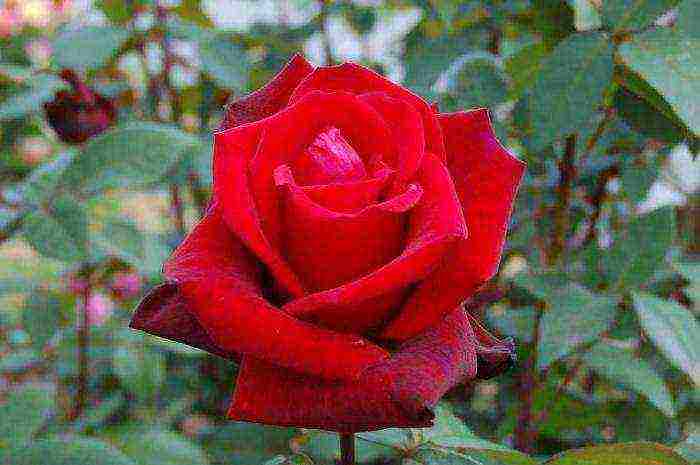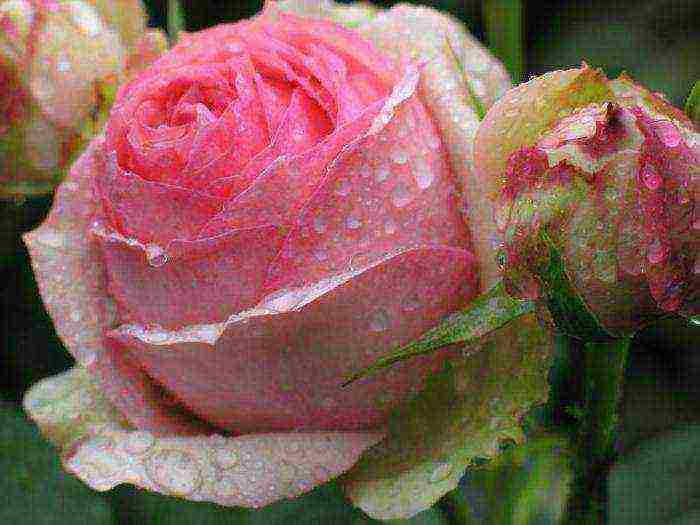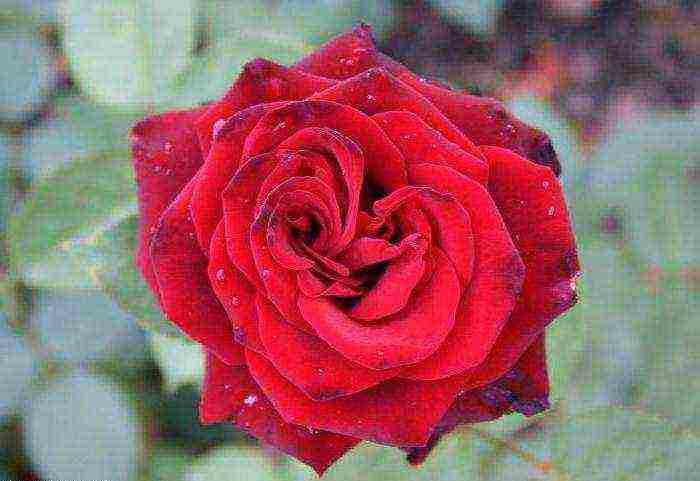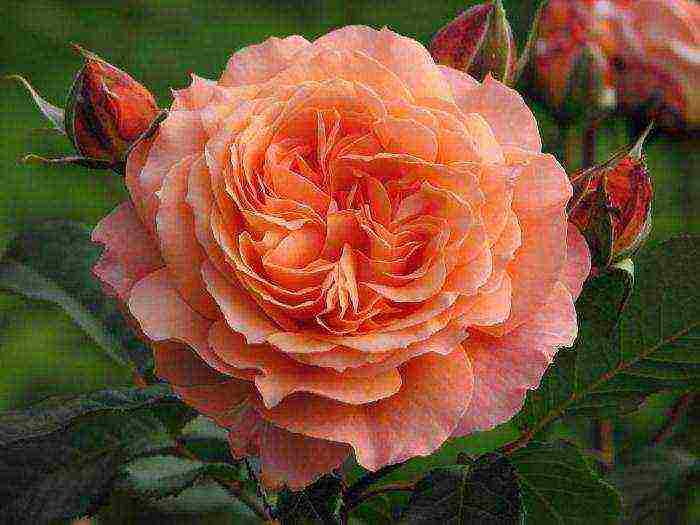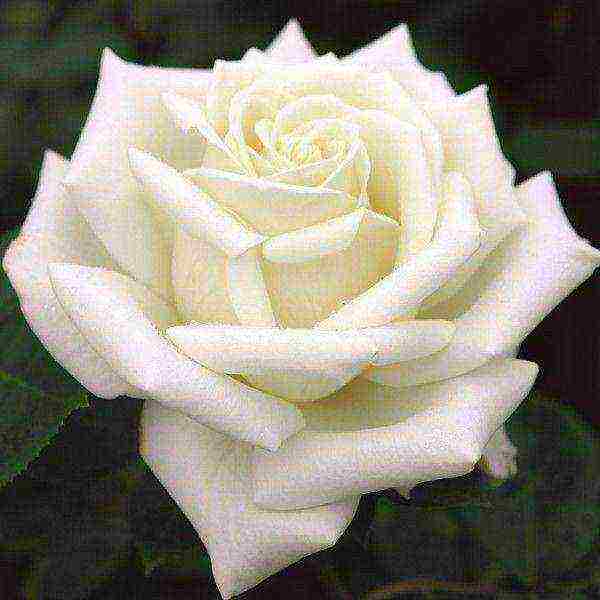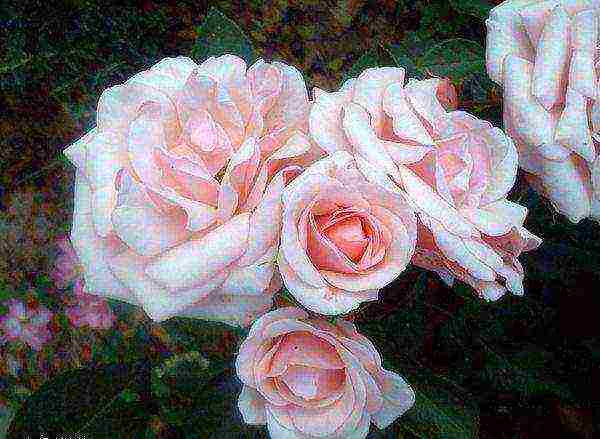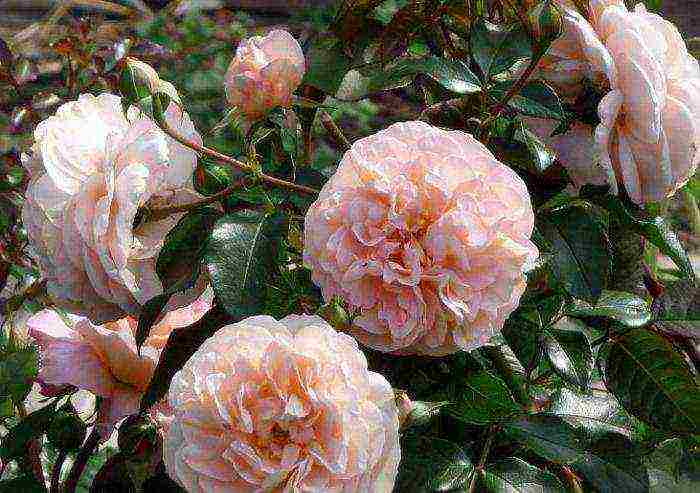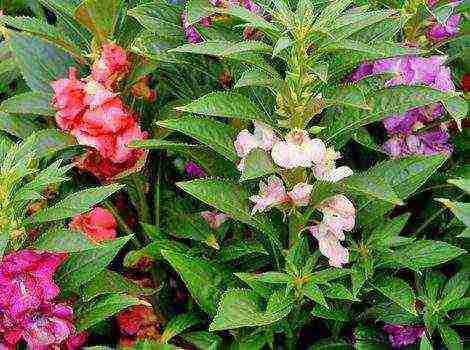Content
- 0.1 Features of Tantau roses
- 0.2 A bit of history
- 0.3 Rose variety 'Aphrodite'
- 0.4 Rose variety 'Aquarell'
- 0.5 Rose variety 'Canary'
- 0.6 Rose variety 'Duftwolke'
- 0.7 Rose variety 'Erotica'
- 0.8 Rose variety 'Fontaine'
- 0.9 Rose variety 'Frohsinn'
- 0.10 Rose variety 'Janina'
- 0.11 Rose variety 'Mambo'
- 0.12 Rose variety 'Mildred Scheel', syn. ‘Deep Secret’
- 0.13 Rose variety 'Montana'
- 0.14 Rose variety 'Pariser Charme'
- 1 Rose variety 'Pussta', syn. ‘New Daily Mail’
- 2 The origin of Tantau roses
- 3 Barkarole
- 4 First lady
- 5 Goldelse
- 6 Mildred Scheel
- 7 Belvedere
- 8 Weisse wike
- 9 Marchenkonigin
- 10 Sebastian kneipp
- 11 Burgund
- 12 Simpathie
- 13 Sangerhauser jubilaumsrose
- 14 Planting roses Tantau
- 15 Further care
- 16 Roses of Tantau: reviews
- 17 Classification of varieties of roses. What types are there and how to distinguish between them?
- 18 Floribunda roses. Varieties, photos, description
- 19 Winter hardy roses varieties
- 20 Climbing roses
- 21 Austin roses
- 22 Ground cover roses
- 23 Canadian roses
- 24 Non-covering roses
Today in the world among the huge
variety of roses
beauties created in Germany by the famous pink dynasty Tantau are especially and well-deserved.

They are not officially singled out as a separate garden group, on the contrary: among the Tantau roses there are representatives of hybrid tea, climbing, miniature, ground cover, floribunda roses.

Despite such diversity, these roses have common features.
Features of Tantau roses
- they have one "cradle", one "paternal home" - the German nursery Rosen Tantau, where all varieties are created;
- very beautiful flowers;
- luxurious aroma;
- flowering profuse and long;
- resistance to fungal diseases, sunburn and rain;
- relative winter hardiness: they need shelter for the winter in central Russia.
A bit of history
The pink empire of Tantau owes its origin to Matthias Sr., who founded the first rose nursery in 1906 northwest of Hamburg. Thirteen years later (in 1919), the first roses of Mathias Tantau, which had large flowers with abundant and long flowering, were presented to the world at traditional International exhibitions. Tantau gained worldwide recognition in 1947 with ‘Garnette’, co-developed with Jackson and Perkins. Since 1953, Matthias Jr. has been at the helm of the pink empire. Since 1985, the company has been managed by Hahn Jürgen Evers, now by Jens Krueger.

Today, as well as 110 years ago, Tantau roses are scattered all over the world.
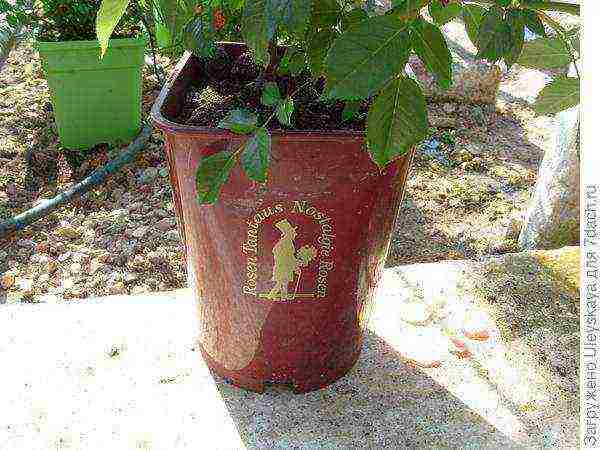
So, we meet 15 of the best, most spectacular beauties of Tantau, including 12 hybrid tea, 2 Floribunda and 1 climbing rose.
Rose variety 'Aphrodite'
A very delicate variety from the so-called romantic or nostalgic beauties of the garden group of hybrid tea roses, conquering with its beauty and immediately “sinking into the soul”, was created in 2006.
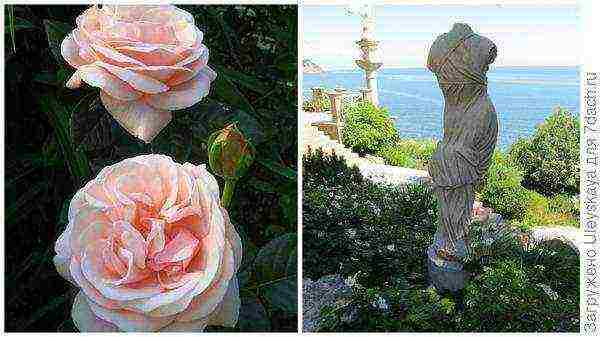
The bushes are compact, up to 0.8 m high. The flowers are light pink, cup-shaped, with a squared center, up to 12 cm in diameter, with a scent in which spicy oriental notes are heard; bloom in early summer (on the South Coast of Crimea (SCC) - at the end of May) and again - at the end of August, September. Suitable for flower beds, groups, cutting. Resistant to fungal diseases.
Rose variety 'Aquarell'
A chic hybrid tea variety of nostalgic or romantic roses created in 1999.
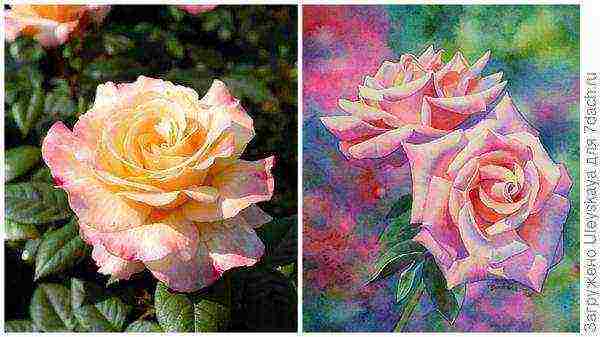
Bushes up to 0.9 cm high. Flowers are pink-peach-yellow in color, up to 12 cm in diameter, with a fruity aroma, single or collected in small clusters; bloom profusely during the summer. Suitable for romantic summer cottages, groups and cuttings. Very resistant to fungal diseases.
Rose variety 'Canary'
A very interesting hybrid tea variety created in 1976.
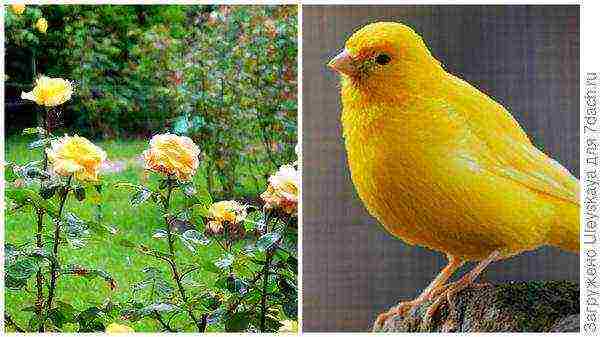
Despite the fact that he is 40 years old, he is still loved and widespread in Europe, but rare in its environment. It is a yellow rose with a "pink" color with large lush flowers 12-13 cm in diameter; when flowering becomes pink. The bushes are vigorous, 1.2-1.4 m high. Flowers are single or collected in 3-7 pieces; bloom during the summer, in the fall.
Rose variety 'Duftwolke'
The luxurious variety was created in 1967, but is still popular and in demand.
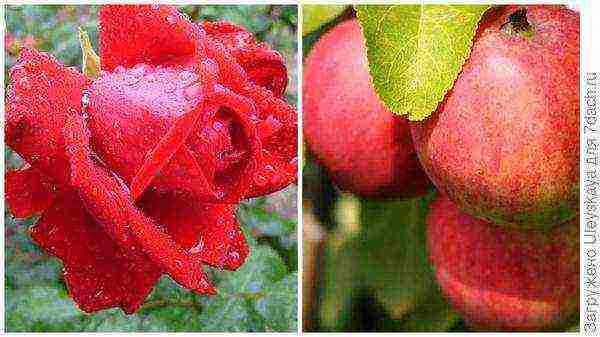
It is among the top 10 most fragrant hybrid tea roses in the world.Bushes are strong, durable, thorny, up to 1 m high. Leaves are dark green, leathery, glossy. The flowers are red (the color is labile, it can vary from brick-red to purple), goblet, with a high center, up to 12 cm in diameter, double, single or up to 10 pieces, with the scent of Damask rose, in which notes of lemon and oriental spices are felt; bloom profusely from early summer to late autumn (South Coast). Suitable for solitary (single) and group planting and cutting. Medium resistant to fungal diseases, sunburn, suffers from rain in cool summers in central Russia (flowers become stained, rot). Awarded with international awards.
Rose variety 'Erotica'
A luxurious hybrid tea with a divine aroma, created in 1968.
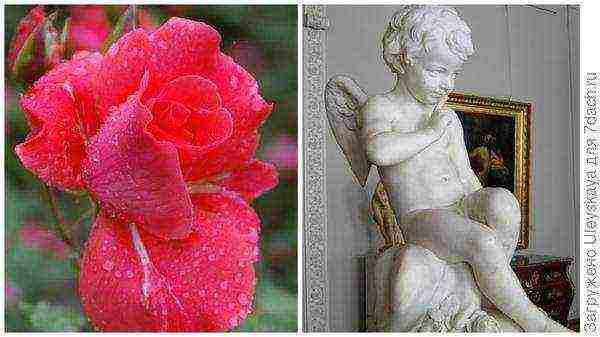
I have known him since August 1983. Then I came to live and work in Crimea, my beloved Nikitsky Botanical Garden, and this rose conquered me with its beauty and aroma. The bushes are compact, densely leafy, strong shoots, with thorns, up to 0.9 m high. The leaves are dark green, shiny. The flowers are dark red, goblet, with a high center, up to 11 cm in diameter, double, fragrant with a sensual classic aroma; bloom in summer and autumn (South Coast). Suitable for single and group plantings, cutting. Young leaves are not resistant to powdery mildew; timely preventive treatments help the rose to cope with this problem.
Rose variety 'Fontaine'
A chic variety from the garden group of climbing (scrubs) roses created in 1969.

Vigorous bushes up to 2 m high. Leaves are dark green, glossy. The flowers are red, goblet, with a high center, up to 12 cm in diameter, double, fragrant, with a pleasant clove scent; there are single, but more often they are collected in inflorescences up to 10 pieces; bloom profusely during summer and autumn (single flowers can be seen on the South Coast in December).
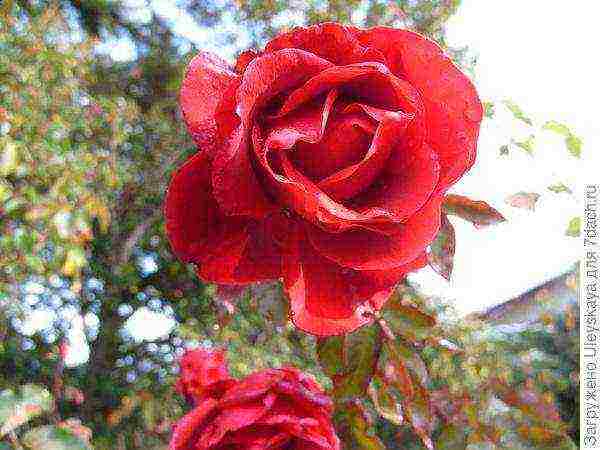
Suitable for trellises, trellises. Resistant to fungal diseases.
Rose variety 'Frohsinn'
A beautiful hybrid tea variety created in 1982.

The bushes are compact, from 0.65 to 1.2 m high. The leaves are medium green, leathery. The flowers are cup-shaped, light pink (as if frozen) with a peach-yellow tint, 10-12 cm in diameter, single or collected in small inflorescences, with a rich tart aroma in which notes of bergamot are heard; bloom profusely in summer and autumn (South Coast). Suitable for flower beds, groups, cutting and standard culture. Resistant to fungal diseases.
Rose variety 'Janina'
A beautiful personalized hybrid tea variety created in 1974.

The bushes are slightly spreading, up to 0.8 m high. The leaves are dark green, glossy. Flowers are orange, up to 10 cm in diameter, double, single or collected in small inflorescences, fragrant; bloom profusely, early, starting in May (South Coast). Suitable for flower beds, groups, cutting. Medium resistant to fungal diseases, can be affected by black spot.
Rose variety 'Mambo'
Timeless incendiary hybrid tea variety created in 1964.
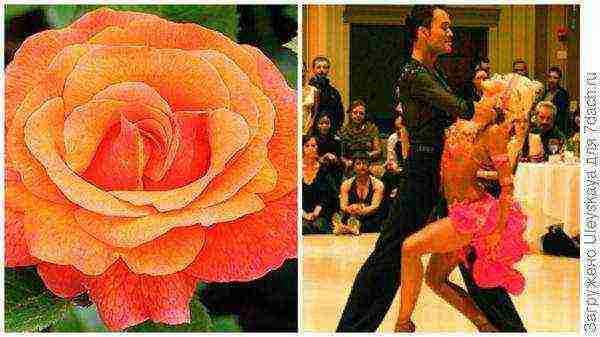
Bushes are strong, with thorns, up to 1 m high. Leaves are medium green, leathery. The flowers are orange-pink, yellow at the base of the petals, cup-shaped, double, single or collected in inflorescences up to 13 pieces, fragrant; bloom profusely in summer and autumn (South Coast). Suitable for flower beds, groups, cutting, forcing in greenhouses. May be affected by black spot.
Rose variety 'Mildred Scheel', syn. ‘Deep Secret’
A chic sensual variety created in 1977; it combines all the positive qualities of the beauties of Tantau at once.
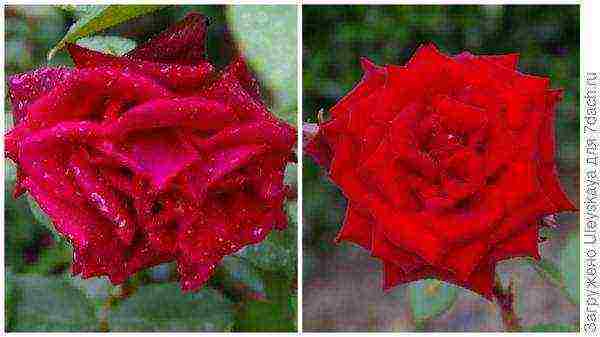
The bushes are vigorous, up to 1 m high. The leaves are dark green, glossy. The flowers are dark red, velvety, goblet-cupped, with a high center, densely double, up to 10 cm in diameter, with a tart, strong, heady aroma, in which shades of lilac are heard; bloom slowly, profusely and for a long time during the summer and autumn (SCC). Suitable for lawn groups, forcing, cutting and standard crops.
Rose variety 'Montana'
A chic variety from the Floribunda garden group, very popular in Germany, was created in 1974.
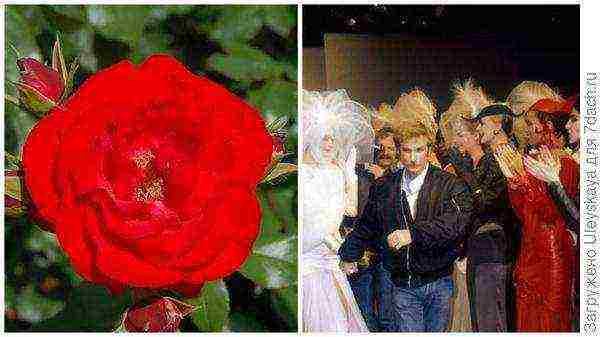
Bushes are straight, strong, up to 0.6 m high. Leaves are dark green, shiny.The flowers are bright red, with an orange tint, up to 10 cm in diameter, double, collected in small inflorescences, fragrant; bloom profusely during summer and autumn (South Coast). Suitable for groups, curbs. Resistant to fungal diseases and sunburn.
Rose variety 'Pariser Charme'
A very beautiful hybrid tea variety created in 1965 and dedicated to the eternal city of love - Paris, its extraordinary charm.
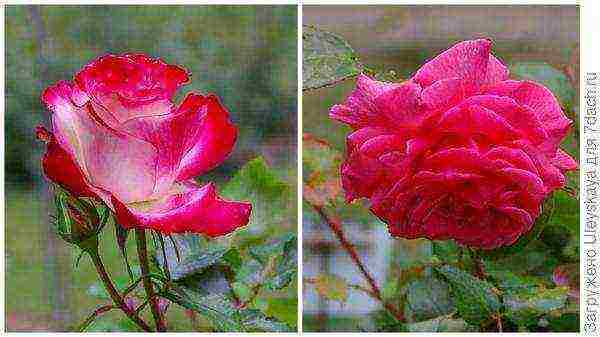
The bushes are medium-sized, up to 0.6 m high. The leaves are light green, shiny. The flowers are pink, goblet in the bud and half-release, then cupped, double, up to 10 cm in diameter, very fragrant; bloom in summer and autumn until November inclusive (South Coast). Suitable for flower beds, groups, cutting and standard culture.
Rose variety 'Pussta', syn. ‘New Daily Mail’
A luxurious variety from the Floribunda garden group, created in 1972, is especially popular in Europe.

Bushes up to 0.5 m. Leaves are dark green, shiny. Flowers are dark red with golden stamens, cup-shaped, up to 9 cm in diameter, semi-double, collected in inflorescences of 12-25 pieces, with a delicate aroma; bloom profusely from late May to late November (South Coast). Resistant to fungal diseases, rain, sun. Suitable for flower beds, groups and standard culture.
Rose variety 'Sophia Loren'
This chic hybrid tea variety was created in 1967 and is dedicated to one of the most beautiful women of our era - Sophia Loren.
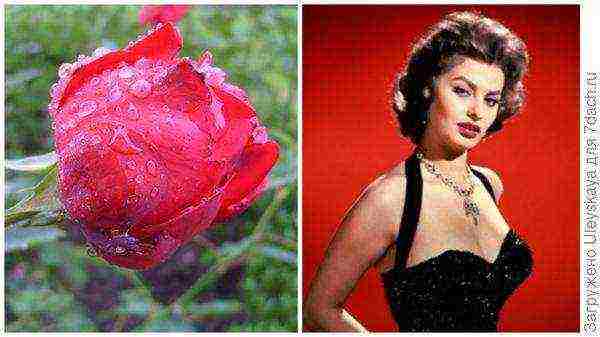
Bushes 1.2 m high with straight shoots covered with large sparse thorns. The leaves are dark green, leathery. The flowers are bright red, cup-shaped, with a high center and pointed petals, up to 12 cm in diameter, densely double, single, with a pleasant strong aroma; bloom in summer and autumn (South Coast). Suitable for groups and cut-offs. Resistant to fungal diseases, rain, sun.
Rose variety 'Wimi'
A luxurious personalized variety from the garden group of hybrid tea roses was presented to the world in 1982.

Bushes are strong, durable, up to 1.2 m high. Leaves are dark green, shiny. The flowers are goblet, with a high center, two-colored - silvery-pink, up to 15 cm in diameter, double, with a delicate pleasant aroma; bloom in summer and autumn until November inclusive (South Coast). Suitable for groups and cut-offs. Resistant to fungal diseases, rain, sun. Titled in 2006 in Baden-Baden.
So our today's short acquaintance with the 15 best roses of Tantau has come to an end. And I am sure that these beauties will very soon appear on your plots, dear seven-lovers, and for many years they will delight with luxurious flowering and exquisite aroma, becoming your pride and happiness.
German company Tantau (Rosen Tantau) has been breeding roses for over 100 years. During this time, its specialists have created many varieties that have achieved international recognition and won prestigious awards.
Albrecht durer
Year of introduction: 2002
Flower type: double
Flower diameter: 10-12 cm
Bush height: 70-90 cm
Type: tea-hybrid
Features: sweet-fruity aroma
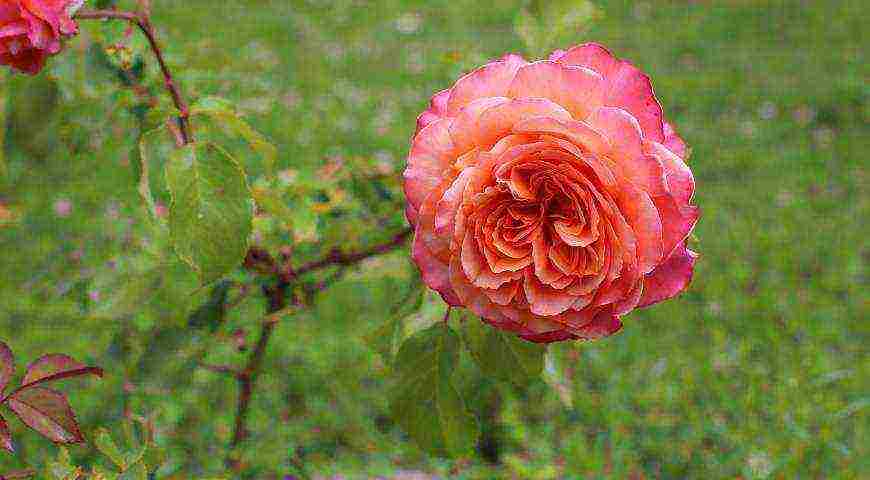
Aspirin
Year of introduction: 1997
Flower type: medium-sized
Flower diameter: 5-7 cm
Bush height: 60-80 cm
Type: floribunda
Features: high resistance to diseases, abundant flowering
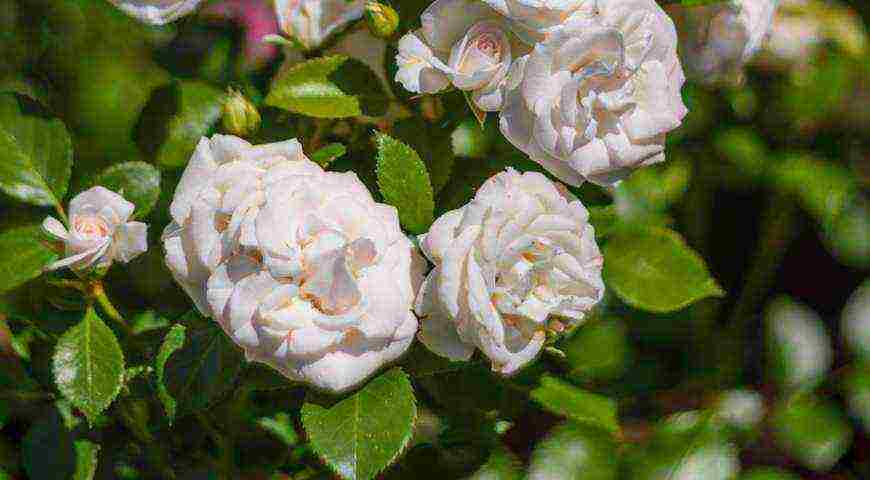
Augusta luise
Year of introduction: 1999
Flower type: double
Flower diameter: 10-12 cm
Bush height: 80-120 cm
Type: tea-hybrid
Features: has a strong fruity aroma
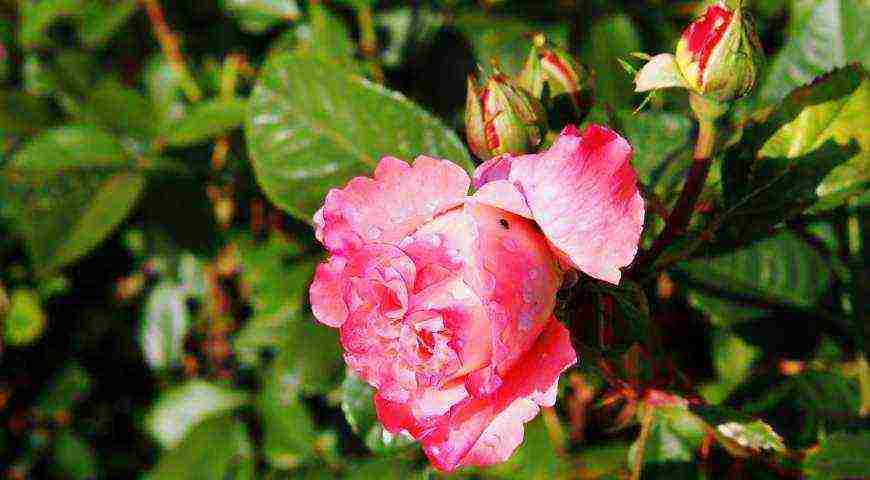
Barock
Year of introduction: 1999
Flower type: double
Flower diameter: 8-12 cm
Bush height: 150-200 cm
Type: climber
Features: part of a series of nostalgic roses, disease resistant, abundant re-bloom, high winter hardiness

Belveder
Year of introduction: 2001
Flower type: medium-sized
Flower diameter: 8-14 cm
Bush height: 100-120 cm
Type: scrub
Features: suitable for group planting. Vigorous bush, abundant flowering
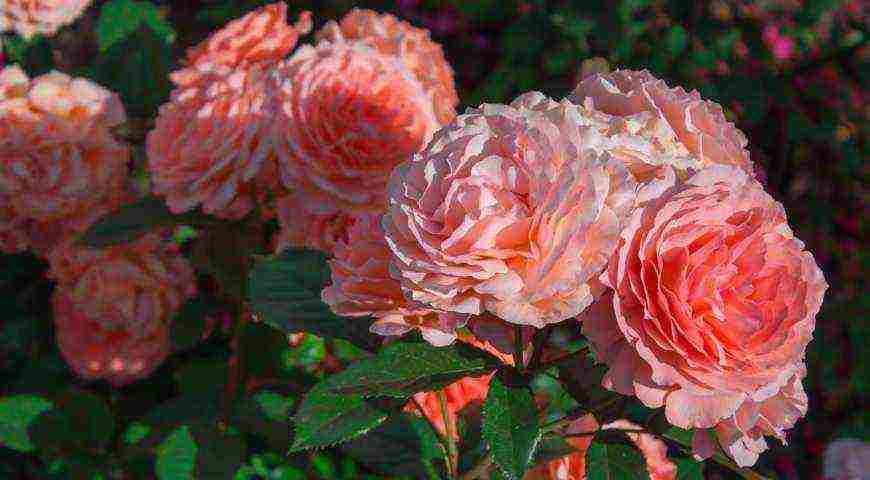
Chippendale
Year of introduction: 2005
Flower type: double
Flower diameter: 8-10 cm
Bush height: 80-120 cm
Type: tea-hybrid
Features: profuse flowering, high disease resistance
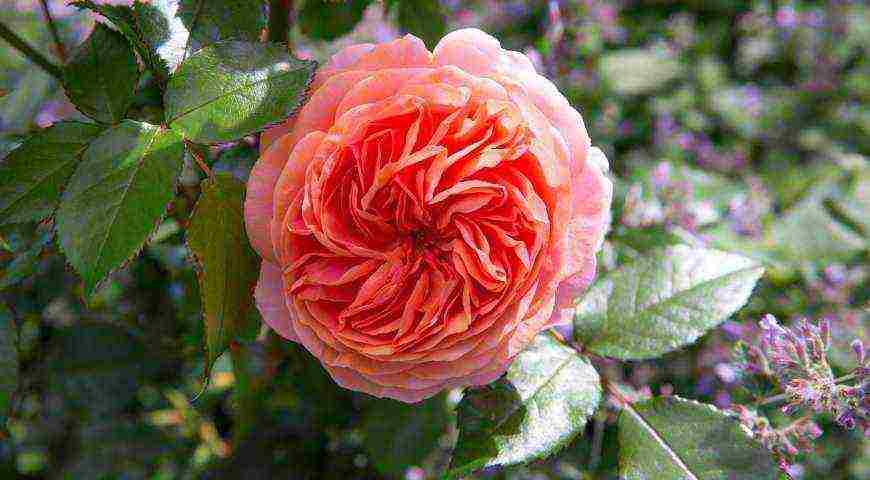
Camelot
Year of introduction: 2011
Flower type: double
Flower diameter: 5-10 cm
Bush height: 250-300 cm
Type: climbing / climber
Features: profuse flowering, citrus aroma, disease resistance
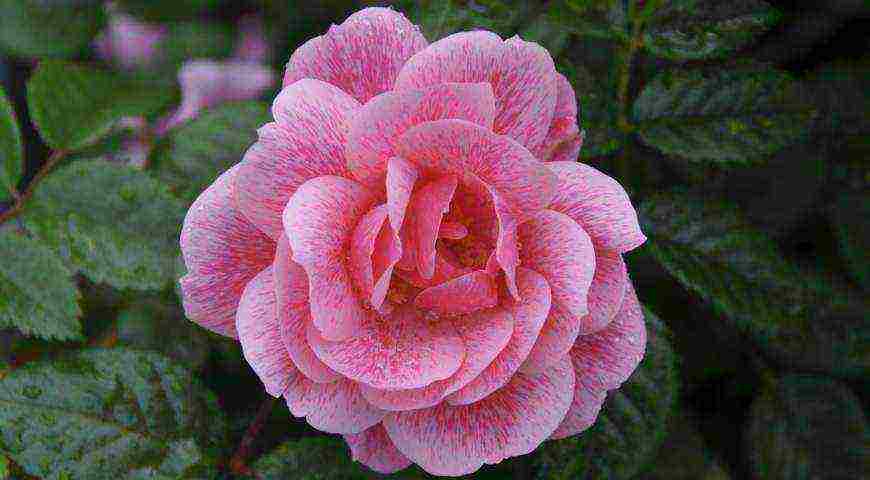
Candlelight
Year of introduction: 1994
Flower type: double
Flower diameter: 10-15 cm
Bush height: 80-100 cm
Type: tea-hybrid
Features: flowers with a strong aroma, resistant to rain and stand for a long time in the cut. High resistance to disease
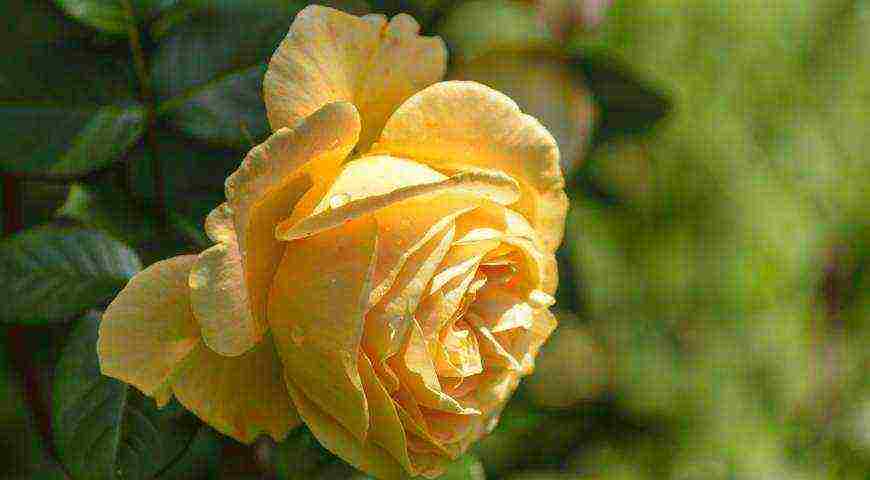
Duftwolke
Introduced in 1967
Flower type: medium-sized
Flower diameter: 10-12 cm
Bush height: 60-70 cm
Type: tea-hybrid
Features: vigorous, disease resistant. Flowers usually appear in early summer, in clusters of 3-7 pieces. Needs protection against black spot and powdery mildew
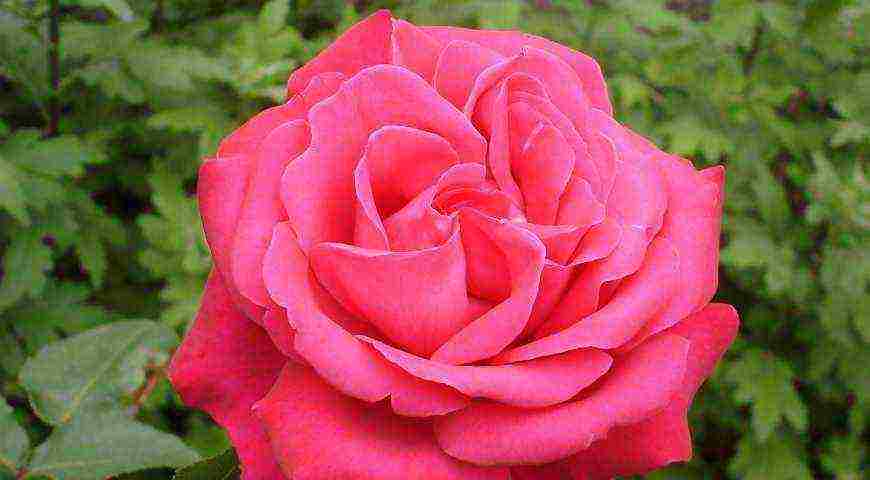
Elfe
Introduced year: 2000
Flower type: double
Flower diameter: 8-14 cm
Bush height: 200-250 cm
Type: climber
Features: romantic flowers of greenish-white color, rare for climbing roses. The bush is vigorous, erect, with large healthy foliage
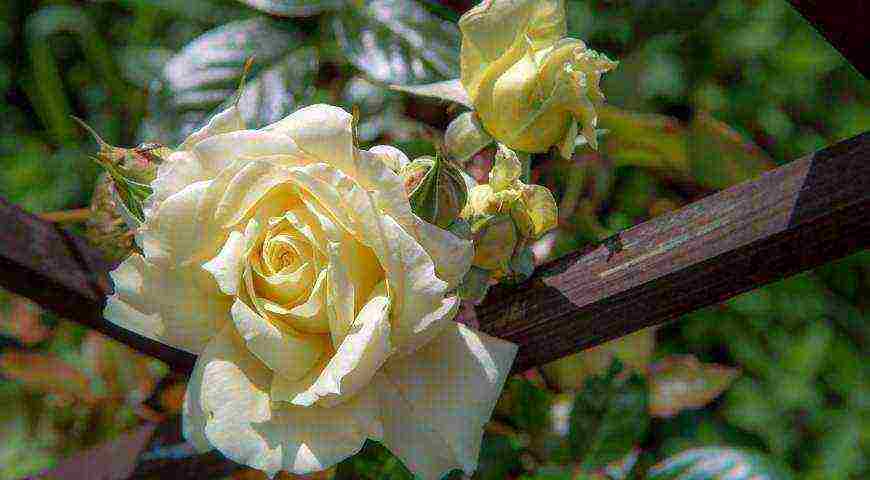
Goldelse
Year of introduction: 1999
Flower type: medium-sized
Flower diameter: 6-10 cm
Bush height: 60-70 cm
Type: floribunda
Features: nostalgic flowers with a pleasant sweetish aroma; suitable for container landing
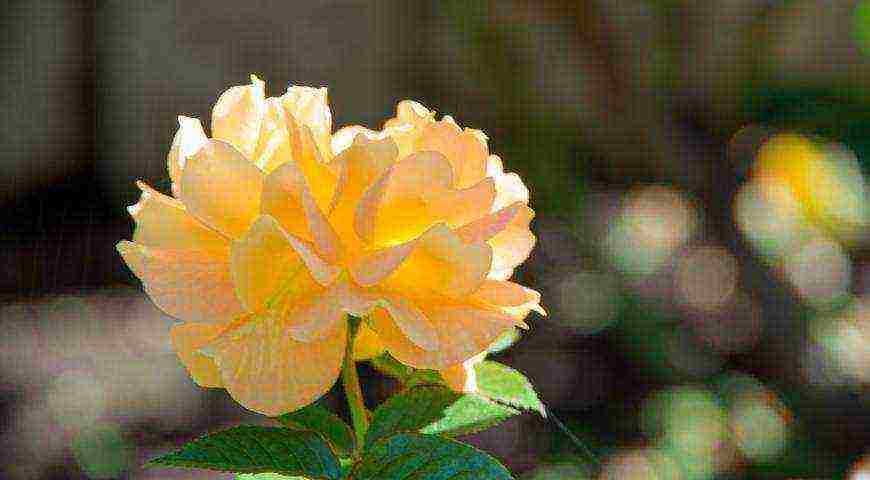
Hansestadt Rostock
Year of introduction: 2010
Flower type: medium-sized
Flower diameter: 8-10 cm
Bush height: 60-80 cm
Type: floribunda
Features: abundant and long flowering, fast growth

Herz ass
Year of introduction: 1998
Flower type: medium-sized
Flower diameter: 10-12 cm
Bush height: 70 cm
Type: tea-hybrid
Features: the bush is compact, low. The flowers are large, single or in clusters, the aroma is weak

Johann wolfgang von goethe rose
Year of introduction: 2004
Flower type: double
Flower diameter: 12-14 cm
Bush height: 100-120 cm
Type: tea-hybrid
Features: rich aroma of roses. The bush is compact, healthy and beautiful
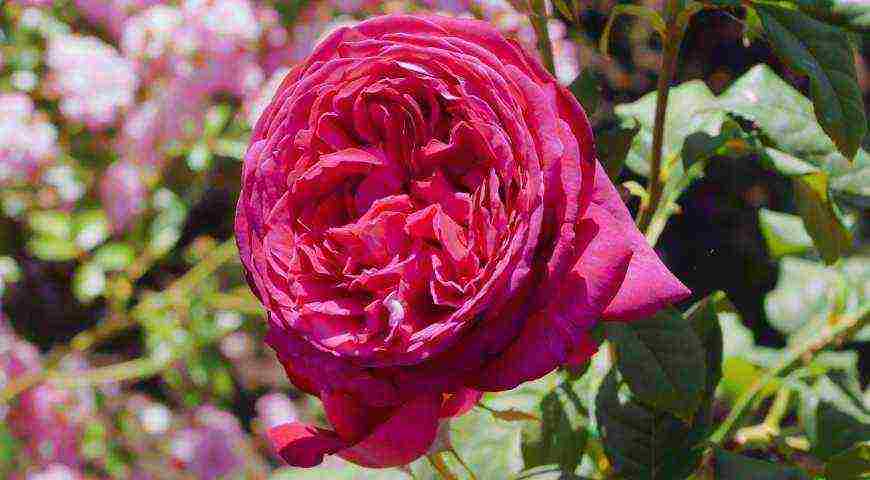
Lavender ice
Year of introduction: 2007
Flower type: double
Flower diameter: 7-8 cm
Bush height: 50 cm
Type: patio
Features: compact bush, highly resistant to rain and disease. Suitable for container landing
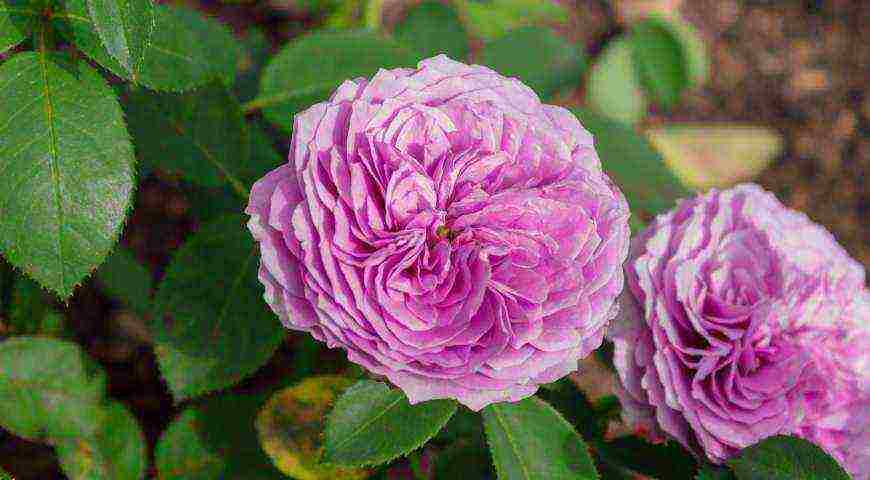
Mainzer Fastnacht (Blue Moon)
Introduced in 1964
Flower type: medium-sized
Flower diameter: 10cm
Bush height: 70-100 cm
Type: tea-hybrid
Features: abundant flowering, winter hardiness
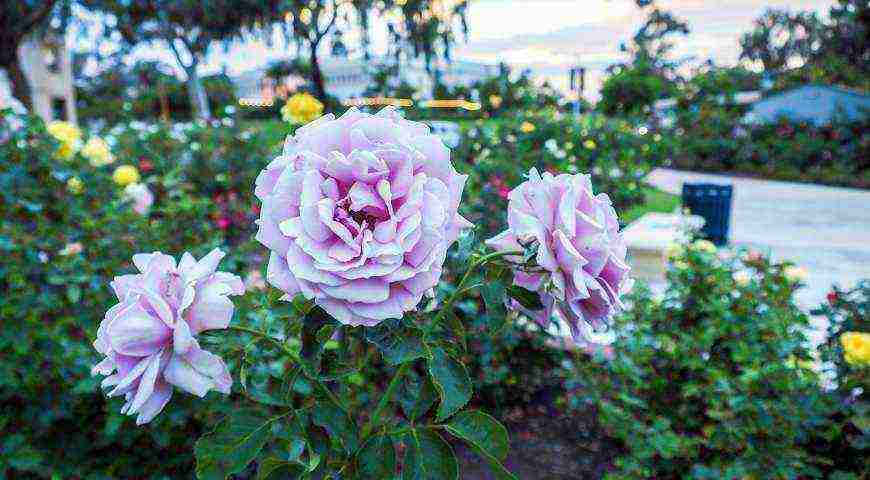
Nostalgie
Year of introduction: 1996
Flower type: medium-sized
Flower diameter: 10cm
Bush height: 80-120 cm
Type: tea-hybrid
Features: has a pleasant sweetish aroma
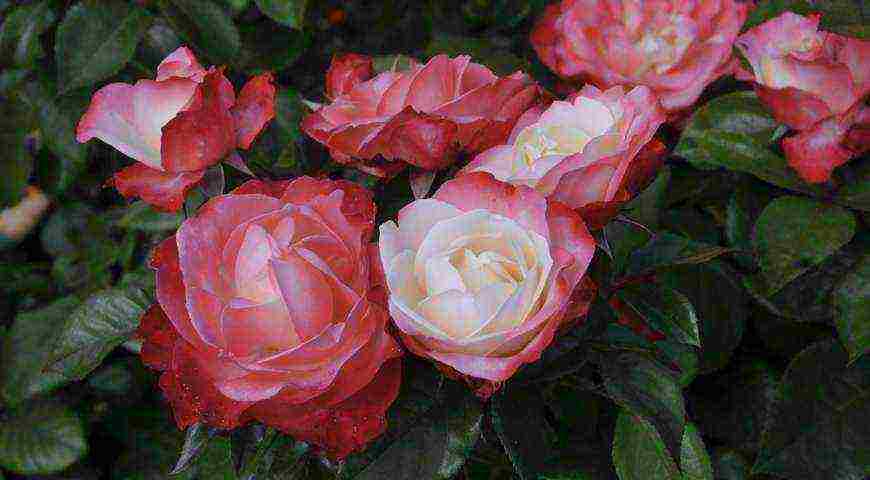
Ocean mikado
Year of introduction: 2007
Flower type: double
Flower diameter: 4-5 cm
Bush height: 40-60 cm
Type: patio
Features: suitable for growing in containers
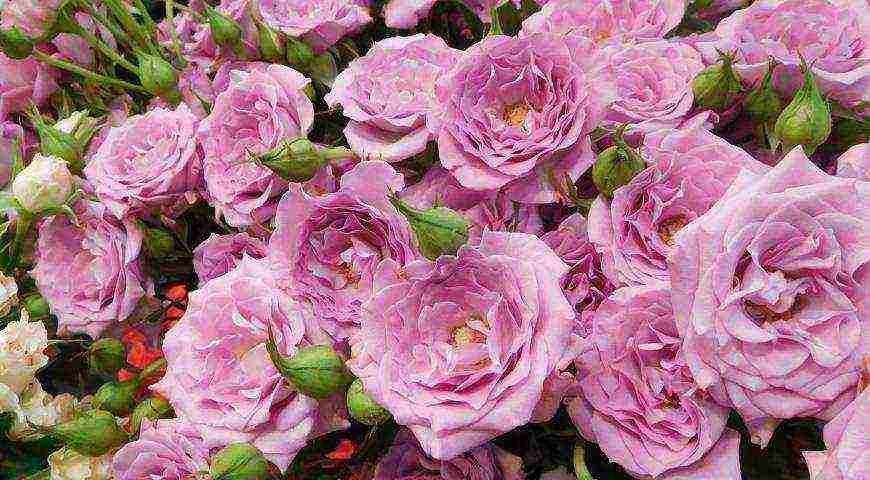
Orange babyflor
Year of introduction: 1994
Flower type: double
Flower diameter: 4-5 cm
Bush height: 50-60 cm
Type: miniature
Features: one of the best varieties for container growing

Summer lady
Year of introduction: 1991
Flower type: medium-sized
Flower diameter: 12cm
Bush height: 100-125 cm
Type: tea-hybrid
Features: Popular show rose, good for cut and flower arrangements. Strong bush, disease resistant, suitable for small garden
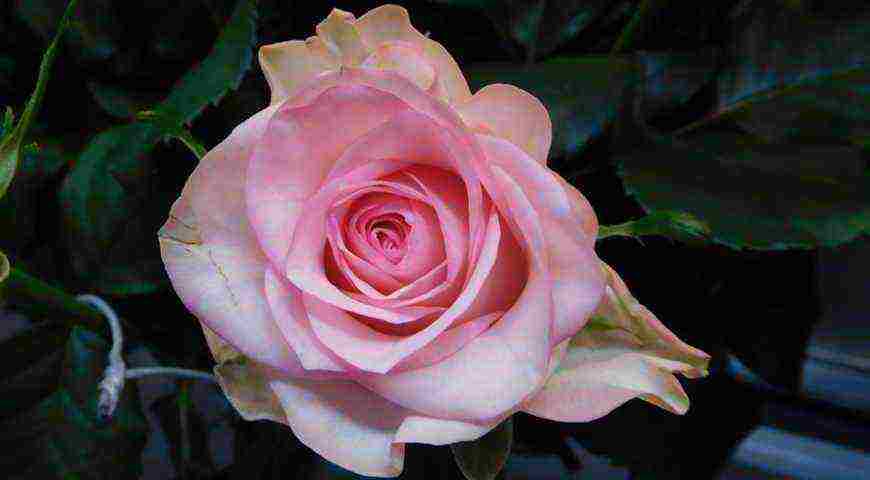
Pastella
Year of introduction: 2004
Flower type: double
Flower diameter: 7-9 cm
Bush height: 60-70 cm
Type: floribunda
Features: long-lasting flowers, lush re-flowering. High resistance to diseases, winter hardy
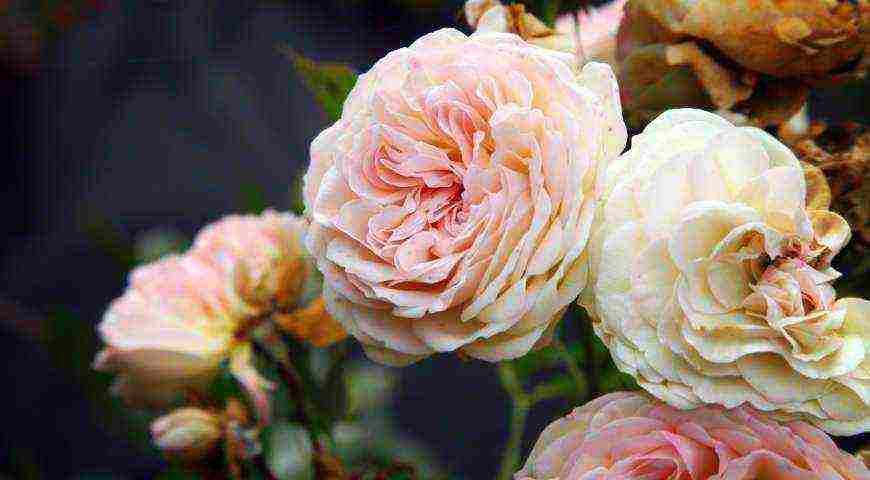
Paprika (Tanprik, Gavroche)
Introduced year: 1958
Flower type: semi-double
Flower diameter: 7-8 cm
Bush height: 80-100 cm
Type: floribunda
Features: has a pleasant aroma, flowers are large, in large clusters, against a background of olive-green leaves
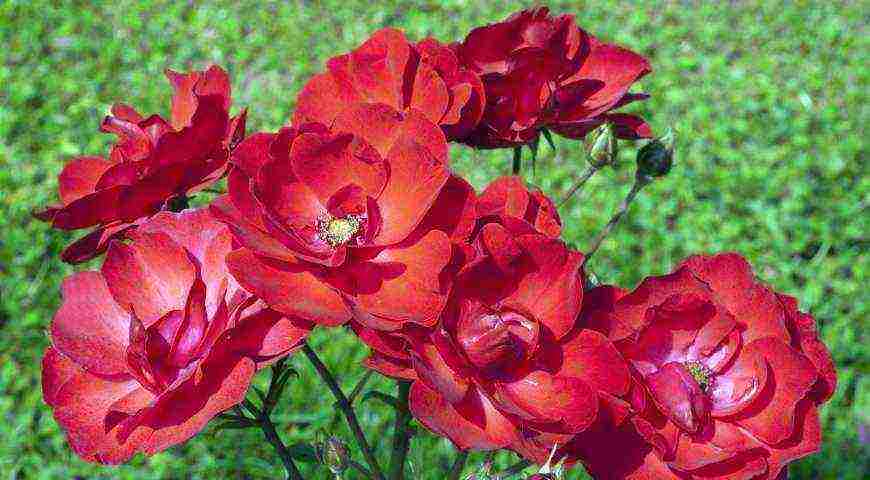
No wonder the rose is called the queen of flowers. She will decorate any celebration, will be a great addition to the gift. Most women love roses more than all other flowers. Gardeners with special trepidation grow these flowers on their plots, of which there are many varieties. Today we will tell you about German Tantau roses. We will describe their appearance, tell you about the varieties, planting and care rules.
The origin of Tantau roses
In 1882, on September 10, in the German city of Jtersen, a son was born to a family of farmers Tantau. Matthias, as the boy was named, having matured, got a job working for Peter Lambert, who kept the largest pink nursery in Germany in Trier. At the age of 23, Matthias started to create his own kennel Rosen Tantau. Work on the cultivation of beautiful plants was carried out and is still intensively carried out, today this nursery is the largest in the world in terms of industrial-scale growing of roses. Tantau seedlings are popular all over the world. There are many types in their assortment:
- climbing;
- bush;
- tea rooms;
- hybrid;
- miniature roses.
About 50 hectares of land have been allocated for the cultivation of flowers. Here roses grow both in the open field and in greenhouses, their number is in the millions!
Barkarole
This is a wonderful variety of Tantau rose. On a high and straight peduncle there is a velvety goblet bud. The hybrid tea rose has a delightful black and red color and is very popular with flower lovers. The buds, opening, turn into large, dense and double flowers, endowed with a pleasant, but not harsh aroma. This rose blooms all season, decorating the landscape with its appearance. Gardeners love this variety because it is ideal for cutting, it pleases the eye for a long time, even in a vase.
First lady
On an erect and rather powerful bush, large and tight flowers slowly bloom for a long time. Their shape is spherical, outwardly reminiscent of small heads of cabbage. Dense double roses have an interesting color: soft green below, above - light pink, and inside the flowers are of a bright shade, close to carnation. The bush branches and grows well, therefore, when planting, it must be allocated enough space.
Goldelse
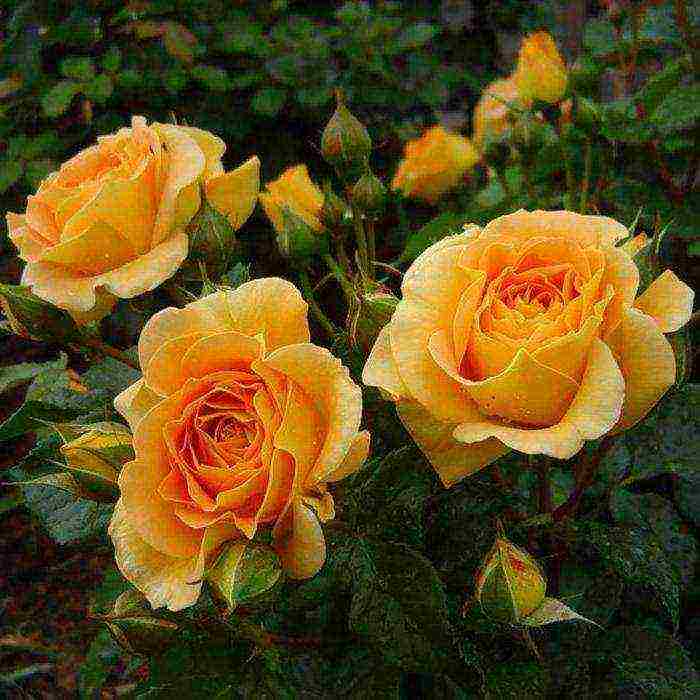
The compact and neat bush of the Tantau rose is endowed with shiny dense foliage. The dense double flowers are collected in large clusters, have an amber-orange hue and a pleasant fruity aroma. Over time, the roses become a pleasant soft peach color, and the wavy petals give them a special charm. This floribunda group is one of the most beloved and recognizable. The bushes do not take up much space, they take root easily.
Mildred Scheel
These are, according to most, the best roses of Tantau. Bushes are tall, straight, flowers are ideal for cutting. The buds are large, almost black, a purple hue is noticeable in the sun. The flower blooms slowly, and the bush is strewn with beautiful plants throughout the season. Having opened, the bud turns into a large, goblet-shaped flower up to 15 centimeters in diameter. It has a bright, rich aroma. The petals are velvety, do not fade in sunlight, so the bush can be planted in an open space. It branches well, it is necessary to take enough space for its growth.
Belvedere
A series of nostalgic roses. Large, but neatly shaped flowers grow on the bush, the diameter of which reaches from 10 to 15 centimeters. Their color is orange-peach, terry petals, gracefully open. The aroma is quite strong, but not annoying, pleasant. In the sun, the petals fade a little, and over time, the flowers acquire a pastel pink hue. Up to eight roses can bloom on the brushes at a time. The foliage of the bush is bright green, shiny, glossy. Abundant flowering, good repetition. The bush itself is large, branched, but neat.
Weisse wike
This is one of the varieties of the Cordes Tantau rose. The bush is fast-growing, wide, brushes with 7-15 buds bloom on its branches. The foliage is dark green, dense. The flowers are heavy, the branches tend to the ground. The buds are pure white in color, they are medium in size, having blossomed, reaching a diameter of 9 centimeters. Semi-double flowers fill the golden stamens in the center with charm. The scent of roses is strong and sweet. If the bush is not cut too much, then it can be grown as a climbing rose.
Marchenkonigin
Tantau roses of hybrid tea variety are endowed with all the qualities suitable for cutting.On long, even stems, large graceful flowers of a pale pink color, terry, rise. The buds bloom very slowly, the open petals tuck their edges outward, forming neat flirty corners. When it rains outside, the flower prefers not to open, tightly gathering its petals. Their foliage is dark green, glossy. One of the main advantages of this variety is that thorns are almost completely absent on the stems.
Sebastian kneipp
Fragrant hybrid tea roses. Their flowers, blossoming from soft cream buds, become almost completely white. The petals are cupped, thick, the rose resembles large children's bows in its appearance. The foliage is glossy, dark green. The bush itself is strong, powerful, fast-growing. Its lower branches are practically devoid of foliage, so when planting it is worth covering its nakedness with other plants or planting it in the background.
Burgund

Classic hybrid tea rose. The bush grows and branches very strongly, but it should be trimmed carefully, as it can be damaged by disrupting flowering. The buds are carmine red, the petals are double. As they unfold, they gracefully bend down at the corners. They do not like rains, flowers are damaged during heavy rainfall, their foliage quickly crumbles.
Simpathie
Hybrid tea, climbing rose. It is one of the most popular plants. On the brushes there are up to ten large double flowers, endowed with a light aroma. The color of the roses is blood red, and in the first flowering the bush is literally showered with beautiful bright flowers. The re-flowering is not so abundant, but still quite dense. The bush branches well, grows quickly. Its branches are powerful and strong, the foliage is dark, glossy in the sun. The dignity of the variety is that it perfectly tolerates natural whims.
Sangerhauser jubilaumsrose
This amazing rose adapts to all weather conditions. Its bush is not too tall, neat. Flowers on it are quite large, their shape is cupped. They bloom with brushes of 3-5 pieces or singly. Initially, their color is creamy peach, over time it becomes almost yellow, which gives the flowering bush an amazing contrast. Nice, does not smell harsh, keeps its shape perfectly in heavy rains. Blooms throughout the season.
Planting roses Tantau
To plant the described flowers on your site, it is recommended to order their sprouts in the nursery. Thus, you will be sure that a healthy plant, grafted from all diseases, will come, adapted to any weather conditions.
It is necessary to find a good place for planting the Tantau rose, the description of the varieties of which we have given above. Depending on the variety, a sunny or shady area is chosen. The earth should be loose, breathable. There should be no strong drafts on the territory, but air movement is necessary. There should be no groundwater near the planting site; Tantau roses do not like high humidity.
The landing pit is prepared in three weeks. It should be up to 80 centimeters deep and at least half a meter in diameter. The soil is mixed with ten kilograms of rotted horse manure and 300-500 grams of wood ash is added. If the soil is too heavy, it is also necessary to mix it with sand in a 3/1 ratio, where three parts of the earth is mixed with manure and ash, and one is sand.
It is necessary to plant seedlings at a distance of a meter from each other. If the plant was brought from the nursery, then its shoots are protected with a wax film, which must be removed by dipping the seedling into cold water. The day before planting, the roots of the Tantau rose must be dipped in a solution that stimulates growth. After that, the seedling is trimmed by 1/3 and planted in a prepared hole, filled with a ready-made mixture of earth, manure and ash by 2/3. The sprout is buried in with the rest of the soil, it is huddled up high.
Further care
In order for a rose to grow beautiful, healthy and strong, to please with wonderful flowers, it needs good care. Three weeks after planting the seedling, it is necessary to rake off the ground with which the bush is raked, and from it build a high roller around the plant at a distance of 10 centimeters.After that, water the seedling abundantly with water, preferably with water settled from the tap or bottled. In the future, the bush needs constant watering, abundant, but not waterlogging, see that there are no puddles around the plant.
An adult rose must be watered at least twice a month, more often in dry and hot weather. She needs a large amount of water for abundant flowering. Watering is carried out only in the evening, when the sun has left the territory, daytime rays can burn the plant.
Pruning is done according to the instructions, depending on the variety of Tantau roses, photos of which are available in this article. For the winter time, it is worth covering the bush well, wrapping it up with dense cloth. It is recommended to throw fallen leaves of trees on the roots or cover them with hay. After that, a plastic wrap or a thick blanket is placed on top. Thus, it will be possible to protect the plant from freezing in frost.
Roses of Tantau: reviews
Varieties of varieties and their types are popular all over the world. Amateur gardeners and professional breeders love to plant Tantau roses. There are a lot of reviews on the network about their varieties.
They write that flowers are great for decorating any landscape. The varieties can be combined, they go well with other plants.
There are reviews about the variety of colors. There are rose lovers who have planted many types of Tantau on their site. They say that they are quite easy to care for, they are not capricious if planted correctly.
They also write that Tantau roses are picky about the place of growth. They feel great both in the shade and in an open sunny space, the main thing is that they are not planted in a lowland. They praise the rapid growth of the bushes, their branching. They write that the cut branches give good, strong roots, and they can be shared with friends, plant additional bushes on your site at no extra cost.
There are absolutely no negative reviews about the Tantau variety. Even novice gardeners were able to find a common language with the bushes, plant and grow them successfully. They write that roses bloom for a very long time, filling the garden with pleasant aromas. They practically do not get sick, they tolerate any weather perfectly, they take root in various regions, even with very severe winters.
Summer residents and gardeners love to decorate their backyards with flowers. In many courtyards, you can see large flower beds and flower beds. Some people even create indescribable beauty from flowers, forming flower beds of continuous flowering. One of the main beauties is the rose. She is rightfully considered the queen of the flower world. It is she who, to a greater extent, is given special preference by both amateur gardeners and professionals. Therefore, many people want to choose the best varieties of roses. How to make the right choice and what should be considered?
The main criterion for the abundant flowering of the bush is the environment and soil characteristics. As many gardeners note, no matter which variety of roses is chosen, you can create a fertile soil for it yourself and concentrate the beds anywhere you want. Thus, the problem with the difference between the flowers you like and the soil conditions unsuitable for them is solved.
Roses with so-called complex colors are very demanding to the composition of the soil. The petals of such flowers have a combination of several shades. They can be very different and combine smooth or sharp transitions. Modern breeders have learned to breed amazing species of this plant, which have not only complex coloring, but also an incredible shape. On unsuitable soil, such plants acquire a depressed state, an unsightly shape and a dull color. Their life cycle is significantly shortened.
Very often people choose David Austin roses. The varieties of these flowers are intended mainly for cultivation in partial shade and in loamy soils. Such conditions are typical for many other species. If we consider in general the soil conditions and the location of the flower bed, then these flowers love light breathing earth.It is categorically impossible to plant seedlings in clay, sandy and sandy loam soil, since it poorly permeates moisture and, practically, does not allow air exchange between the root system and the soil. Experts recommend, in this case, to carry out a double digging with the addition of chernozem, peat, sod land and well-rotted manure. In this case, the proportions should be kept approximately equal.
The best place to plant roses is on the southeast side of your patio, garden or backyard. The place should not be dark, shaded by buildings, trees or ornamental shrubs.
As for the climate, then the resistance of a particular plant species to changeable weather conditions, to cold weather, heat and lack of air humidity should be taken into account. Are absolutely contraindicated for the colors of the place of north-western orientation at the summer cottage. Plants are very sensitive to drafts and cold winds, so roses will not grow well in such areas.
Classification of varieties of roses. What types are there and how to distinguish between them?
The opinions of many experts and florists boil down to the fact that before you start growing these beautiful flowers, you need to find out as much information as possible about them in order to avoid mistakes. After all, in the end, every grower, regardless of qualifications, wants to get high-quality, fragrant and beautiful roses. Species and varieties are divided into several categories. In each of them, there are the best options that have proven themselves on the positive side in all respects.
The most beautiful and common types of roses are:
- Floribunda.
- Hybrid tea.
- Grandiflora.
- Groundcover.
- Climbing.
- Shrubs.
- Selected by David Austin.
When choosing a variety, you must take into account your preferences and tastes, then your favorite flowers will appear on your personal plot.
Floribunda roses. Varieties, photos, description
The history of these flowers began in 1924, when the Danish originator by the name of Poulsen first bred the original flowers of this type, which were called hybrid-polyanthus. At first, they belonged to the general category of tea roses, and were bred into a separate group in 1976. Some experts note that floribunda roses are intermediate varieties between the two types (hybrid tea and climbing). A distinctive feature of these colors is the diversity in everything. This is especially true for the combination of shades and tones. As a rule, they are rich, colorful, juicy.
General characteristics. The height of the bushes varies from 40 cm to 1.5 m, about 35 inflorescences can be collected on one stem. The flowers themselves have from 8 to 24 petals, the edges of which are distinguished by medium doubleness. In shape, some varieties resemble a narrow or wide glass, while others can bloom with flat or cupped buds.
The description of floribunda rose varieties also shows that their individual specimens can have golden clear shades, which are distinguished by a glossy surface and rigid petals. Such plants have an average height (about 1 meter). They are also characterized by larger flowers, which are collected in small inflorescences.
It should be noted that floribunda is a continuous flowering rose. They are also resistant to frost, fungal and viral diseases. This is an excellent solution for decorating your summer cottage or home yard.
The best floribunda roses, varieties with photos:
- Golden Vedding (Golden Wedding) German selection.
- Samba. Germany, selection W. Kordes.
- La-Paloma (La Paloma). Germany, breeding Tantau
- Lion-Rose. Germany, selection Kordes.
- Leonardo da Vinci. France, breeding Meilland.
- Tchaikovcki. France, breeding Meilland.
- Gebruder Grimm. Germany, selection Kordes.
- Pomponella. Germany, selection Kordes.
- Jubile du Prince de Monaco. France, breeding Meilland.
- Koncerto (Concerto). France, breeding Meilland.
- Purpl Tiger (Purple Tiger). France, breeding Meilland.
Hybrid tea roses: varieties, photos, description
This group has a very interesting history. Back in 1867, the Frenchman J.-B.André Guillot was engaged in the cultivation of flowers that were unique at that time. For years he experimented with La France, crossing remontant and tea roses. As a result, he created a wonderful plant that had many differences and its own unique zest. Then André Guillot positioned his brainchild as a variety of bourbon roses.
In the description of varieties of hybrid tea roses, their main feature is listed - the continuity of flowering. Also characteristic of these flowers are easily-cranked or straight stems, which have increased strength. They create erect, slightly spreading shoots. The varieties of hybrid tea roses were classified into a separate group in 1997.
The bushes are characterized by low shoots. Their length is a little less than a meter, they have large racemes with 4-7 leaves. Most often, flowers are collected in small inflorescences of 4-6 pcs. The shades are very different (in some varieties, several colors can be combined). There are new varieties of hybrid tea roses that have complex large double flowers.
Almost all varieties of hybrid tea roses have a beautiful appearance and are perfect for decorating not only a summer cottage, but also premises. The average period of initial, active flowering lasts about a month. Then comes the time to move to the next stage - the emergence of new flowers (15 days for early varieties and 30 days for later). Then they bloom continuously until the first frost.
The best varieties of hybrid tea roses:
Medium-sized varieties:
Red-pink varieties:
Rose varieties of the Grandiflora group
A relatively new type of flowers, developed for decorating gardens. They look like a low-growing tree, about 1.5-2 m high. This group of flowers was obtained by crossing floribunda and hybrid tea varieties. Grandiflora embodies the best qualities of these varieties. They have a very attractive appearance and a wonderful aroma. Notable properties are resistance to disease and frost.
The best varieties of Grandiflora roses:
Ground cover roses: varieties, photos, description
The name of this group contains the main answer to the question about the main characteristics of the plant. Groundcover - low-growing roses that are able to cover a vast area of the flower bed with long shoots with many flowers blooming on them. The length of the shoot can at times reach up to 4 meters. Thus, nature creates a natural, beautiful carpet.
There are also ground cover roses, varieties of which, in addition to creeping on the ground, shoot drooping shoots. This type of growth provides an indescribable beauty to the bushes. Some species bloom once a year (they are rarely used by summer residents). It is the continuously flowering varieties of ground cover roses that are very popular.
Roses also have ground cover varieties (see photo), which are characterized by a variety of shades (light pink or pale crimson, red and dark red, light red or pure white). The buds have a variety of sizes.
Another feature of these flowers is frost resistance. Many varieties do not shed their foliage until spring. They are good for decorating columns or walls in the yard. Despite this, the base of the plants should be covered for the winter.
Ground cover roses, winter-hardy varieties (photo):
Roses shrabs: varieties, photos
Speaking about this group of flowers, one can note their main feature - a magnificent aroma, neat, upright bushes, abundant and continuous flowering. Flowers can be of various shapes (there are small ones, and there are large ones, the diameter of which reaches 12 cm). Petals are double, semi-double or simple. The leaves do not have a glazed surface; they can be dark green with a burgundy tint.
It should be noted that shrub roses were introduced into a separate group in 1954. It was then that many very beautiful species of this plant appeared.
Due to its structure and powerful root system, the formation of a bush is very easy, the main thing is to cut it on time.For example, flower growers very often form a ball, cone or strict square. This is not difficult to do. Some summer residents use this plant to form a decorative hedge to highlight one or another area of the personal plot.
Roses are grown shrabs (see varieties with photos) summer residents, both in separate flower beds, and in combination with other types of flowers. They are often used in the planning of gardens or parks, which is why shrub roses are called landscape or park roses.
There are three groups of scrub (park) roses:
- Curly - the length of the shoots is from 5 to 16 m.
- Climbing - shoots length up to 6 m.
- Semi-plaited - the length of the zero shoot reaches a little more than 3 m.
Erect bushes can reach heights of up to one and a half meters. Among the advantageous properties is frost resistance (especially Canadian park roses, the varieties of which can withstand a temperature drop of up to 350 C of frost). They bloom all summer until late autumn continuously, delighting the eye with their indescribable beauty and aroma.
The best varieties of scrub roses:
Roses bred by David Austin
The origin of this group of flowers is very interesting. An English breeder named David Austin began breeding completely new types of roses. He experimented for a long time, crossing classic floribunda and tea hybrid with varieties of long-forgotten old French and Damascus roses, which have already lost their popularity and demand among gardeners and summer residents.
As a result of his hard work, flowers of a completely new format were obtained, which began to be called Austin roses. The varieties he bred have very attractive shapes, with intricate petals and the structure of the bud itself. They are also characterized by new aromas. Many experts compare the smells of these flowers with the aromas of expensive, natural and real teas.
The best varieties of Austin roses are very beautiful and are often grown for the trade. Despite the variety of forms of shoots, bushes and an abundance of flowering, the presentation of all varieties of rose leaves is not lost.
The work done by the English breeder has a great price. For example, breeding a single resistant variety requires 4 to 8 years of diligent attention and careful approach. Austin devoted his whole life to this business, which is more than 60 years. From a very young age, he started a business that brought him the most pleasure. The nursery he created, which is located in Shropshire, is still engaged in the development of new types of Austin roses. The catalog of varieties with photos is constantly updated with new types of these flowers, which have incredible beauty and advantageous properties.
It should be noted that the climatic location of Shropshire (western part of England) contributes to the endowment of Austin flowers with unique properties - resistance to severe weather conditions and diseases.
Austin roses, photo varieties:
Climbing roses: continuously flowering varieties
According to the description and characteristics, the budding and flowering phases of these beautiful plants are very extended. Shoot formation occurs constantly. This property contributes to the continuity of flowering. This period can last up to six months without interruption. Paying attention to this feature, many designers and flower growers use them to decorate complex and simple building elements of their homes and courtyards. The best, in this regard, are Climings or Banks.
Also, varieties of climbing roses that grow all summer can be divided into three groups according to the nature of growth:
- Curly. The length of the shoots is up to 15 m.
- Climbing. Shoot length up to 5 m.
- Semi-plaited. The length of the branches does not exceed 3 m.
This classification is not accidental. The fact is that claimings bloom on young shoots, and ramblers use branches from past years. The approach to plant breeding and the formation of a beautiful, climbing bush depends on this nuance.
The most beautiful varieties of climbing roses:
This article provides a description and photo of the most popular, beautiful, fragrant and original varieties of roses.Therefore, flower growers and summer residents have a good opportunity to purchase those flowers that best suit his tastes and requirements.
Flower lovers (and we are among them) are worried: how are our roses in the country? This year's winter is classically abnormal. In many regions there was no snow for a long time, although there were no severe frosts. Then it got colder. Then snow fell, and more than necessary. Now here is the dancing temperature, streams are flowing. Then frost will hit again and everything will be covered with a layer of ice ... Poor plants!
How they will survive the next bad weather, we will find out in the spring. But so that every winter I study the weather forecast not to clutch at my heart, heed the advice of a specialist.
The well-known rose collector, Muscovite Alexei Stepanov, tested many different roses on his site and compiled a list of the most reliable ones. It included 30 varieties. And they all meet 5 main criteria:
1. Excellent health. This is one of the main qualities, since a sick rose does not just spoil the appearance of a flower garden, it also hibernates badly. Or even dies. After all, the affected leaves fall off ahead of time, and the plant simply does not have time to ripen.
2. Stable wintering. In different areas, in different conditions and with different shelters, they are still able to survive our severe frosts.
3. Abundant and long flowering. There are no such roses in nature to bloom without interruption all summer, but these varieties will inflate as long as possible.
4. Resistance of flowers to bad weather. They are not afraid of rains, moisture and heat - in any case, they retain their decorative effect.
5. Good shoot regrowth. This is important when the aerial part of the plant dies after an unsuccessful wintering. After all, the more new stems grow, the more flowers there will be.
So, roses that won't let you down.
Hybrid tea
Gloria deiMeilland, 1945 This unsurpassed masterpiece is called the number 1 rose in the world. She is really magnificent: her flowers are large, yellow with tints and pink edging of the petals.
The only drawback is that each flower lasts only 3 days.
Ingrid bergmanOlesen, 1984 Gorgeous, dark red, with almost black buds - this is without exaggeration the best red variety for the middle strip. Perfect and inimitable. The bush grows quickly, the flowers last up to 2 weeks and are not at all afraid of rains.
AphroditeTantau, 2006 No wonder this rose was named after the goddess of love and beauty - she is the embodiment of beauty! Her flowers are 10–12 cm in diameter, porcelain-pink in color. They tolerate rain well. The bush is low, up to 80 cm.
Hommage a barbaraDelbard, 1997 Perhaps the best rose in the Delbard collection. Her flowers are delightful burgundy with black bloom and wavy petals. Each shoot blooms 1 bud, but there are always a lot of stems on the bush, the flowers last up to 2 weeks and are not at all afraid of rains.
FloribundaThere are 7 varieties in this group at once. They are delightful. They are resilient. They will decorate any garden!
Sangerhause jumbileumroseKordes, 2003 Its delicate, large (up to 9 cm in diameter) flowers in apricot-pink tones look very impressive against the background of dark green foliage. Branched bush. Not afraid of disease, heat or rain. Blooms all summer and is very abundant.
Leonardo da VinciMielland, 1993 As you know. Leonardo da Vinci was the greatest artist and ingenious inventor. And the rose, named in his honor, as if seeks to justify the high honor shown to her. Her bush is straight and compact. In the first bloom, it is literally strewn with bright pink pompom flowers, very close in shape to the old varieties.
The only drawback of this beauty is that she almost does not smell. But it never fails.
Lios-roseKordes, 2002 She is always included in the top ten charts compiled by a survey of rose lovers - in terms of reliability, she is not equal! Cream-white flowers bloom slowly on large clusters and change shape daily.
The disadvantage of a rose is that in the middle lane it wakes up much later than other roses, develops slowly and blooms only at the end of July. Therefore, it does not have time to bloom a second time.But in our harsh conditions, this disadvantage turns into a huge plus, because, failing to plant the buds again, the rose has time to prepare for the cold and always winters well.
PastellaTantau, 2004 The bush of this wonderful variety is very beautiful, with bright dark green foliage. Flowers 7-8 cm in diameter, unusual creamy white color with pinkish and green tints. They are collected in multi-member clusters that bloom profusely and continuously. The rose has excellent health and winters well.
Jubile du prince de monacoMielland, 2000 The main advantage of this rose is its “long-lasting” flowers, each of which lasts up to 2 weeks and at the same time constantly changes color: at the time of dissolution, they are white with a red edging, then turn red, and as they fade, they become white-green.
The rose has two drawbacks - it does not smell and in unfavorable years it is affected by black spot. But on the other hand, it feels great in gray latitudes.
Gebruder GrimmKordes, 2007 This rose has been awarded the ADR quality mark, which is awarded to the most decorative and resistant varieties. Her flowers are of a unique yellow-orange-red color. Small, 6–7 cm in diameter, but always collected in large racemes. It always creates a bright accent in the garden, so it is better to plant it separately from other roses, for example, against the background of conifers. Otherwise, she will draw all attention to herself and other varieties next to her will be lost.
PomponellaKordes, 2005 She is short, but blooms very profusely. Her flowers are small, pom-shaped, intense pink, collected in large brushes of 15-30 pieces!
ShrubsThis group also has a fairly extensive selection of stable and unpretentious roses - 7 varieties that will not let you down and will delight you with health and abundant flowering.
WesterlandKordes, 1969 Very spectacular and unusual rose - her bush grows quickly and blooms in two pronounced waves. The flowers are semi-double, copper-orange. And although each of them lasts only 3 days, they take in quantity - there are a lot of buds in the brushes and new ones are constantly replacing the fallen ones. In very harsh winters, it can freeze slightly, but quickly recovers. Possesses the ADR quality mark - for high decorative effect and durability.
AngelaKordes, 1984 The flowers of this wonderful rose are medium-sized, up to 4 cm in diameter, but an incredible amount of them is formed. They are bright pink in color, collected in numerous brushes, which cover the leaves. In catalogs in photographs, she usually does not look very presentable, and flower growers often bypass her with their attention. But those who planted were not disappointed - this is a real queen! Nothing sick and all in bloom. No wonder she was awarded the ADR quality mark.
Bonica 82Mielland, 1985 The ideal rose for beginners! She easily forgives mistakes in pruning and shelter for the winter, and every summer she pleases with abundant flowering. Her flowers are light pink, slightly fading. They are not large, 5–6 cm in diameter, but they open constantly, in any weather, right up to the snow!
The only drawback is that it doesn't smell at all.
Rhapsody in blueFrank R. Cowlishaw, 1999 This is the only blue rose in the top 30. And this is the bluest of all roses! More precisely, it is blue-violet. The flowers are not large, but collected in large brushes. Rain resistant. The bush grows up to 1.5 m and looks very impressive surrounded by dense yellow roses.
Louise Odier (Madame de Stella)Margottin, 1851 Notice the year it was bred - it is over half a century old! This is an old Bourbon variety that will give odds to many modern ones. Very hardy and winter hardy. It can even be left without shelter in the winter. The bush, of course, freezes above the snow level, but quickly recovers. With good cover, the plants are tall and very dense. The flowers of this rose are of an old cupped shape, 5–7 cm in diameter, dark pink in the center and lighter at the edges. And what a smell! Saturated, strong.
By the way, it is from this variety that rose oil is most often made and jam is brewed.
LarissaKordes, 2008 It appeared on the market relatively recently, but has already managed to conquer gardeners with excellent health and abundant flowering. Its flowers are small, 5–6 cm in diameter, pale pink, densely double, old-fashioned, collected in large brushes. This variety will perfectly complement English roses with large flowers.
Guy SavoyDelbard, 2001 The only rose with striped petals to make it to the list of trusted varieties. It is so powerful that in France it is recommended to make hedges from it.In our conditions, it is, of course, a little more modest, but, nevertheless, it grows up to 1.5 m, forming very tough shoots. They cannot be bent down for the winter, so the bush has to be cut to the height of the shelter. The flowers of this rose are weakly double, but large, of a rare pomegranate shade with white strokes. Each brush contains 9–20 buds.
EnglishThis group included 5 varieties that showed themselves at their best in the harsh conditions of Russian reality.
Graham thomasAustin, 1983 This is one of the best varieties of selection by David Austin. Several years ago, he was the last, 14th in a row, to take a place in the World Rose Hall of Fame. It blooms very profusely. His flowers are bright yellow, do not fade and are considered the standard of yellow in roses. In our climate, it will grow very quickly, reaching a height of 2 m.
Crown Princess MargaretaAustin, 1999 An incredible variety - during the flowering season, its shoots are covered with caps of densely double light orange flowers of an old shape with a strong aroma. It can be grown like a climbing rose, with minimal pruning, keeping the shoots from last year. In this case, it will bloom almost along their entire length.
James galwayAustin, 1985 This variety in warm countries forms a powerful bush 2 m high and the same size in circumference. However, in Russia it does not work that way - the shoots are very hard and it is impossible to bend them to the ground, so you have to cut them to the height of the shelter. The flowers of this rose are cold pink, very fragrant, collected in a brush.
Mary roseAustin, 1985 This is one of the first varieties that brought David Austin worldwide fame. The qualities of the variety are outstanding. Tall and strong arched shoots create a beautiful bush shape. They fit easily for wintering. Cold pink flowers with a lilac tint fully convey the charm of real old roses. One of the first to bloom in the garden, and one of the last to finish flowering.
Crocus roseAustin, 2000 The most popular flowering rose in our country. A powerful, spreading bush grows quickly - this variety has never had problems with replacing shoots. Her flowers are white, with an orange center - they look just amazing!
GroundcoverThere is only one variety here - only it has fully shown itself to be reliable and very decorative.
Sunny roseKordes, 2001 This variety fully justifies its name ("sunny" in English means "sunny") - if you want to have a yellow carpet in your garden, then it was created especially for you! Pleases with abundant, almost continuous flowering. In brushes up to 12 large rich yellow, fading to creamy flowers. An adult bush covers an area of about 1 sq. m. It has the ADR quality mark.
ClimbingThere are quite a lot of reliable roses in this group - 6 varieties at once have shown themselves at a height in our difficult climatic conditions.
FlammentanzKordes, 1955 A very spectacular rose with red petals. It blooms once, but so abundantly that it literally overshadows other roses! Her flowers are resistant to rain, open in any weather and stay on the bush for a long time. It grows well on its own roots and perfectly cuttings, therefore it wanders from garden to garden.
Rosarium UetersenKordes, 1977 Growing fast. It blooms profusely all season with bright crimson flowers. It is considered a petite, but in our climate it does not grow to the declared size and is usually grown as a scrub. Looks great and blooms on a trunk. Over time, its shoots become thick, they are difficult to lay, so the bush for the winter has to be cut to the level of the shelter.
Pierre de Ronsard (Eden Rose)Mielland, 1987In our conditions, its lashes reach 1.5–2 m. It looks beautiful on a lattice support, if you distribute the shoots on it in the form of a fan. But you can grow it in the form of a bush, tying it to vertical supports to protect it from the wind. By the way, it is often called the “rose of paradise”. Indeed, when you stand near an adult flowering bush, which is adorned with an abundance of creamy white flowers with a bright pink edge, it seems that such beauty can only be in paradise.
But this rose has 3 drawbacks: weak aroma, instability of flowers to rain, and thick shoots, which have to be bent for the winter in 2-3 doses.
JasminaKordes, 2005 This rose amazes with excellent health and abundant flowering - new shoots have caps of up to 50 buds! The flowers are medium-sized, cup-shaped, with the most delicate pink-lilac tint and an amazing aroma! And what is more pleasant - the shoots fit well in the winter.
Dorothy perkinsJacksaon & Perkins USA, 1901 It is not without reason that this climbing rambler rose has been so popular in the world for more than 100 years - its powerful bushes 3 m high and more than 2 m wide are strewn from top to bottom with cascades of small, 3-5 cm in diameter pink flowers. The foliage is small, glossy and completely covered with flowers during flowering. Blooms once. Looks great on a high trunk - its long shoots gracefully hang down in a luxurious waterfall.
RaubritterKordes, 1936 This outstanding rose is over 80 years old, but it still drives flower growers all over the world crazy. Belongs to the group of ramblers. It blooms once, but very profusely. The flowers are medium-sized, 5–6 cm in diameter, and resemble pom-poms in shape - they seem to have descended from old paintings. The shoots are very thorny and flexible, easily bend in any direction, so there are no problems with laying them for the winter.
P.S. Please note - most of the roses in the list of the rose collector Alexei Stepanov belong to the selection of Cordes. And this is not surprising, because the climate in Germany is closest to ours. Heat-loving French women are still lagging behind in disease resistance. And one more thing: in this list of reliable roses, as you noticed, there are no varieties of Canadian selection. But they are ideally suited for our harsh conditions. Yes, only their decorativeness, to put it mildly, for an amateur.
Based on materials from the magazine "Gardener Bulletin", April 2013
Rose is a beautiful flower with a delicate aroma and spectacular appearance that can revive even the most dull flower garden. The variety of forms and palette of this plant allows you to advantageously arrange a different landscape of the site, carry out vertical gardening, grow a hedge or reproduce the royal greenhouse at home. Hardy roses can decorate the rose garden or front garden of site owners in cold areas.
Winter-hardy roses varieties
Rosa is the Latin collective name in botany for representatives of the Rosehip genus, the Rose family, or Rosaceae. It is impossible to call this flower unpretentious. For a seedling, it is necessary to carefully select a place, lighting, soil. Requires constant care for them throughout the season. Obligatory procedures for such a pet to be healthy, actively develop and bloom regularly, are constant treatment against various microbial, fungal diseases, insects, balanced and timely feeding, pruning.
Read more about Caring for the queen of flowers - a rose.
Most of the wild species live quietly in the climate of the middle zone and endure frosty winters with almost no damage. Cultivated species are not so immune to cold, so growers often suffer losses. To solve this problem, scientists and botanists have resorted to selection. The result of their labors was winter-hardy varieties of roses.
After carrying out the necessary preparatory work on the site, the question arises of which winter-hardy roses should be purchased. The wide assortment in garden centers and specialized stores will not disappoint the consumer. Further, the most unpretentious and winter-hardy representatives of the family will be considered.
Video "How to lay a rose garden correctly
Climbing roses
Frost-hardy climbing roses can be represented by small-flowered specimens like rose hips and new large-flowered species that bloom several times per season and have striking colors.
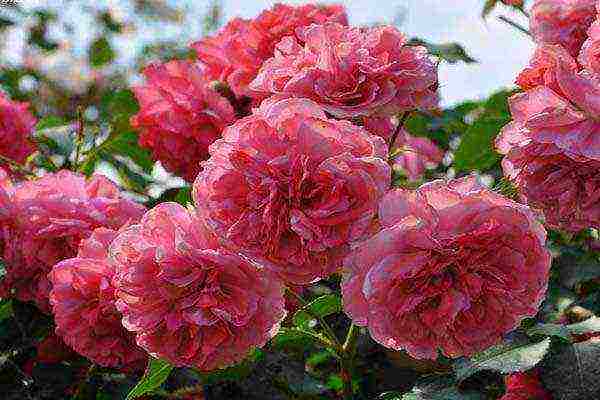
Climbing rose variety "Rosarium Utersen"
Rosarium Uetersen Is a large-flowered representative obtained by growers in 1977. But popularity began to gain in the zero years. The buds reach 15 centimeters. The palette is limited to shades of pink.The lush and bushy crown bears fleshy foliage. They are planted on the south side, bearing from adjacent plants and supports (building, fence) by half a meter.
Large blooming "Santana" forms single buds up to 12 centimeters in diameter, or brushes of several flowers. The three-meter bush is completely covered with blood-red flowers and pleases the eye for a long time. The landing site should cover an area of 50 by 50 centimeters in the southern part of the territory. Planted in spring or autumn.
Big buds are dissolved by a rose "Polka" with a diameter of 15 centimeters. Delicate peach or cream color. Abundant undulating bloom several times a season. The bush is low - no more than 2 meters.
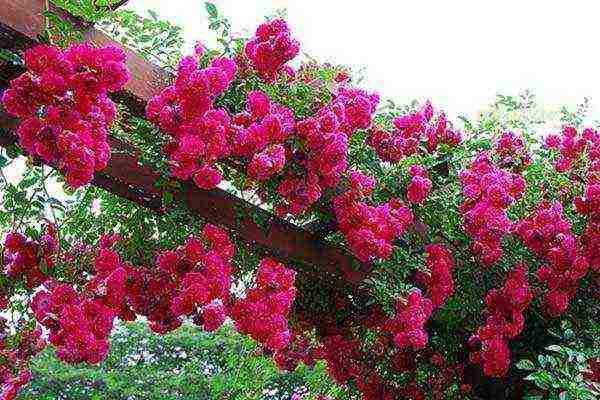
Winter-hardy climbing rose grade "Super Excelsa"
Small-flowered "Super Excelsa" leaves buds of no more than four centimeters, lilac color, almost purple. Terry flowers. It is advisable to determine the seedling in the shade, since the petals are very delicate and will quickly lose their appearance in the sun.
"Snow Goose" has miniature flowers that cover the bush continuously. Brushes can form up to 20 buds. The thorns are practically absent. The variety is used in vertical gardening and as an independent plant.
"Super Dorothy" - small-flowered with abundant flowering until the first frost, but the first flowers appear only by the beginning of summer. Reaches three meters in height. The palette has many shades, but the most popular color is crimson.
Austin roses
Austin roses are often called "Austin roses", "Austin roses". The first samples were bred by the famous breeder David Austin at the end of the 20th century, who destroyed the stereotype of the usual goblet rose and began to display buds of various shapes, inspired by the flowers of old roses.
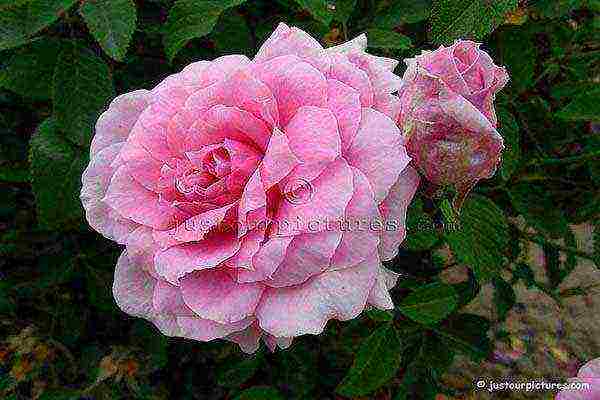
Austin roses variety "The Mayflower"
"The Mayflower" - the first representative of this variety, resistant to disease and frost, awarded a royal award. The flowers are soft and small, pale pink in color, with a strong pink scent. Flowering begins in spring and lasts until the first frost.
Susan William-Ellis»Blooms at the end of May. White flowers stand until frost. They have a bright odor. Shrubs are suitable for planting curbs and hedges.
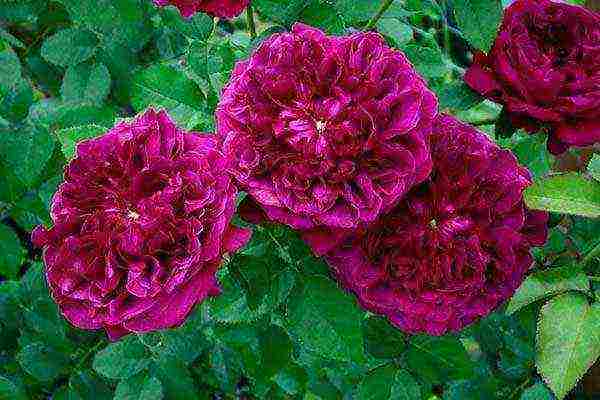
Austin roses variety "William Shakespeare 2000"
William Shakespeare 2000 - this is the most spectacular frost-resistant rose from the category "Austin roses". Forms a lush, dense and vigorous bush. The diameter of the flowers reaches 10 centimeters, which are collected in a brush. Each brush maintains flowering for up to two weeks. Greens are pure green in color. Lilac flowers become more saturated over time and darken by several shades.
Hyde Hall - large rose bush. Blooms for a long time. Produces a large number of buds. Due to its size, it can appear in the background or be grown as a hedge. It is very hardy, therefore it is capable of abundant re-flowering.
"Wild Edric" often mistaken for rugoza. Brushes are oblong and densely folded with semi-double flowers of deep pink color with purple tints. By the end of flowering, the rosettes fade to pale lilac. It has a light, unobtrusive aroma with a hint of cucumber.
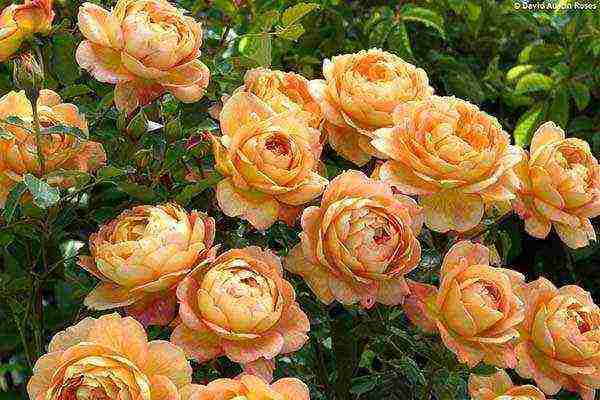
Austin roses variety "Lady of Shalott"
"Lady of Shalott" has flowers of unusual color. The petals are of a heterogeneous orange-pink-coral-apricot color with a pale yellow underside and a rich salmon-orange center. Despite such a delicate appearance, it is very resistant to diseases and frost-resistant. Under favorable conditions, it grows rapidly and forms large branches. The smell matches the color - warm, apple, tea and clove.
Graham Thomas Is the variety that has become the most popular among many yellow brethren. Few varieties, even among hybrid tea, have such a pure yellow color without shades. Cup-shaped double buds with a diameter of 7-10 centimeters exude a tea aroma. Forms a large bushy crown. Abundant flowering pleases the eye for a long time.
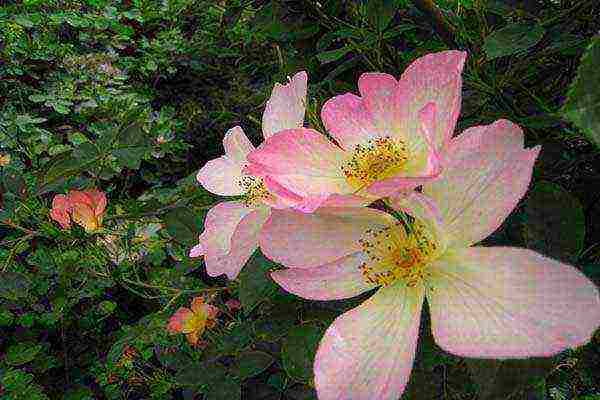
Austin roses grade "The Alexander Rose"
"The Alexandra Rose" - an uncharacteristic representative of Austin roses. The ancestor of this variety is the Alba rose. The flowers are similar to wild rose hips. In the center there are pronounced stamens. The color changes with age from salmon pink to almost white. The brush can be covered with buds, up to 20 units. The thornless crown has spreading shoots.
Benjamin Britten is a very effective rose bush with a coloration atypical for the English rose. The petals are bright red with orange notes and form a bowl around a deep-set center. It contrasts well against the background of more gentle brothers. The bush crown is formed by branchy shoots intertwined with each other. Has a bright aroma with reminders of pear wine and fruit.
Video "Austin Roses - a story about the history of their appearance"
Ground cover roses
Ground cover roses include many members of the genus in their group. Got their disease resistance and excellent frost resistance from wild rose hips. Do not need regular pruning. Easy to care for. A distinctive feature of this category of plants is the presence of long and winding shoots, falling and creeping in a carpet - hence the name.
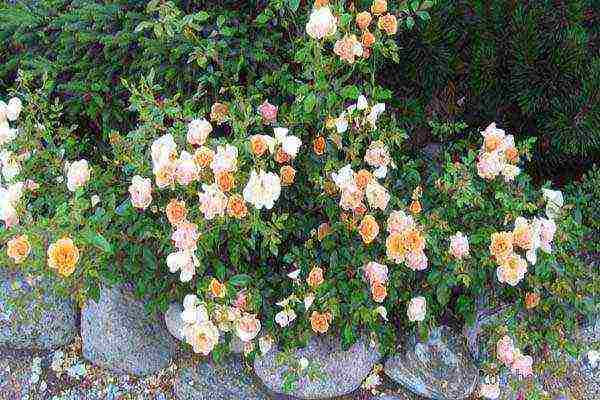
Winter-hardy ground cover roses grade "Amber Sun"
"Amber Sun" has a wide crumbling bush with shiny and fleshy greens up to half a meter high. The clusters are formed by buds, up to 8. Shoots densely cover the area around the bush. The petals have a honey-yellow warm color.
"Eskimo" ("Eskimo") - medium-sized scrub. The bush is erect, reaching a height of 80 centimeters, which allows the variety to be used as a hedge. Brushes are formed by small white rosettes up to 8 units. Very unpretentious. No pruning required.
Stadt Rom striking in its splendor. Fuchsia buds, not terry, like rose hips. About this they say: "Blossoms like crazy!". The crown is dense and compact with well-branching shoots.
Canadian roses
Canadian roses are sectioned by crossing the Rugosa with the species and Cordes roses. From the name of the group, it is clear that they were first bred in Canada for the appropriate climate. They are distinguished by high endurance of low temperatures (down to -40 ° C).
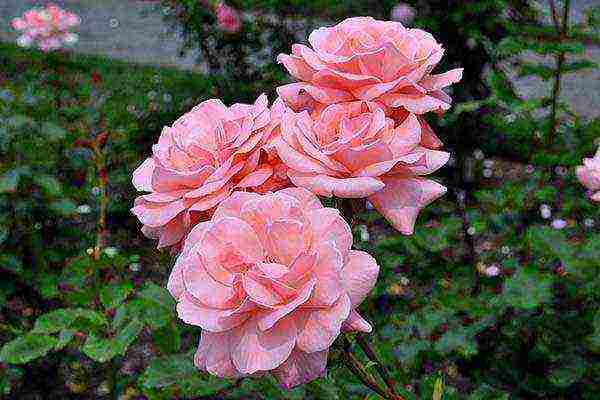
Floribunda rose cultivar "Queen Elizabet"
Queen Elizabeth has pale pink petals, tightly collected in a semi-double flower. They fade in the sun, losing color saturation. The buds form a large brush of up to 15 flowers. Every six years, it is necessary to carry out a rejuvenating pruning of the bush, which means removing the shoots almost at the root in early spring. It is the first representative of the "grandiflora" category, although this group is not recognized in all countries.
Arthur Bell - floribunda rose. It begins to bloom early. Repaired. Yellow petals fade under the rays, so it is worth shading, but not much. Smells like sweet fruit. Accustomed to the weather of Northern Europe.
J.P. Connell " - yellow rose from the Explorer collection. Petals are pastel lemon yellow. Does not form large brushes. In the center of double flowers in the shape of a bowl, red stamens "sit". Without pruning, the crown becomes vigorous. Produces undulating blooms.

Winter-hardy roses grade "Leonardo da Vinci"
Shrub roses "Leonardo da Vinci" floribunda type. Abundantly flowering bush with very large flowers, juicy pink. Inflorescences are numerous with densely double flat flowers. Delivers a delicate pink scent. Despite the rich and aristocratic appearance, they act as very resistant specimens to the diseases "powdery mildew" and "rust".
Read also Unpretentious and beautiful - Canadian roses
Non-covering roses
Uncovering roses are refined rosehip varieties. These wild roses bloom once and produce juicy fruits.
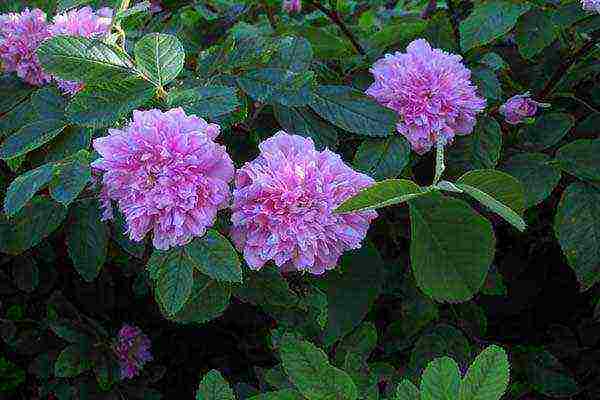
Non-covering roses grade "Tornedal"
"Tornedal" is of Scandinavian origin from Rosa majalis. The flowers are flat, double and small, pale pink in color.In the middle there are pronounced stamens.
Malva and Foecundissima also belong to Rosa majalis. Beautiful and easily growing bushes of these varieties are used in park landscaping and hedges.
Speaking of winter-hardy roses, their resistance to diseases and frost is often mentioned. This undoubtedly makes the work of the grower easier. However, cultivated roses are very capricious plants. Choosing even the most unpretentious variety, it is worth remembering that you still have to take care of it in order to get abundant flowering and ensure healthy growth of the bush. Serious immunity does not provide protection from insects, drought and heat, "wildness" of the bush without pruning. Winter-hardy roses require careful shelter for the winter and the right place, otherwise severe frosts can still destroy the flower. Do not think that strong varieties of roses can grow on their own.
Video "Preparing roses for winter"

What varieties of roses grow on your site? Which ones would you like to try to grow? The variety of roses existing today is so huge that even with a strong desire, life will not be enough to experiment with all known varieties. Therefore, flower growers so carefully choose the types of roses and individual varieties worthy of taking a place among other plants in the flower garden.
Types and varieties of roses ideal for the Russian climate
But the complexity of the choice lies not only in the fact that the eyes run up from the presented assortment - not every variety of roses can be grown due to the peculiarities of the local climate. Nevertheless, in most of the territory of Russia, the summer is very short, and the winter is frosty, which is why delicate roses do not gain color or even freeze out. Let's look at varieties that have long been successfully grown in domestic gardens.
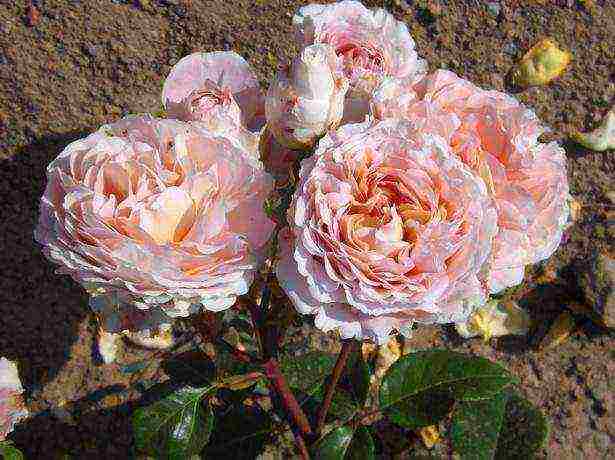
For open ground, choose those varieties that are least susceptible to damage in winter.
As good as the Dutch roses, presented in every flower shop in the form of luxurious bouquets and elegant single flowers, are very difficult to grow them in our climate. Their delicate root system is not able to withstand severe frosts, and in general Dutch roses are very capricious - at best, you can achieve success by growing these roses in a greenhouse or at home in pots, surrounding the flowers with maximum attention and care.
Video about varieties of roses
For open ground, choose the varieties that are least prone to damage in winter. For example, park roses and rose hips (wild rose) are considered the most resistant to frost. The best frost-resistant varieties include such a variety as the Cordes roses.
Winter hardy roses native to snowy Canada
Not only our country is famous for long snowy winters and strong frosts - Canada is located in similar latitudes, and local gardeners have the same problems with growing roses. But it was the Canadian breeders who came to grips with breeding winter-hardy roses, starting their work at the end of the 19th century. Since then, Canadian scientists have achieved excellent results, and Canadian roses have become famous all over the world for their unique qualities. These flowers are able to withstand frosts down to -40 degrees, are not afraid of diseases and even in adverse conditions grow abundantly and continuously.
Officially, only the Explorer and Parkland groups belong to Canadian roses, however, flower shops often sell American-bred varieties and old frost-resistant wrinkled roses in the guise of Canadian roses. The winter hardiness of the Explorer and Parkland varieties is different - some roses are well able to withstand our winters, while others freeze to the level of snow, but then recover and bloom well in summer. Even with the complete freezing of the aerial part, Canadian roses grow again from the buds on the roots.
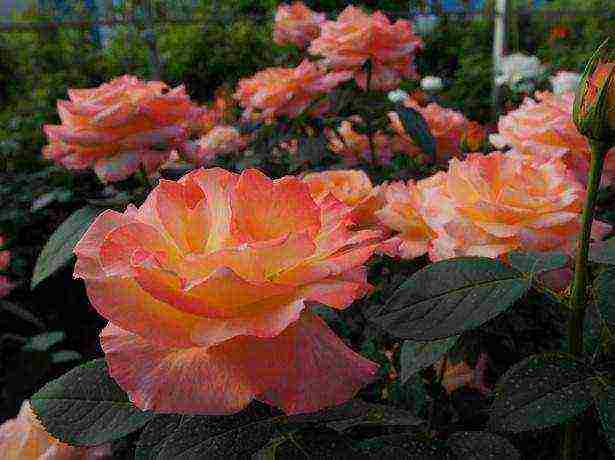
Even with the complete freezing of the aerial part, Canadian roses grow again from the buds on the roots.
The best winter-hardy varieties of the Explorer series: John Cabot, Alexander MacKenzie, Lambert Closse, Marie-Victorin, Louis Jolliet, Quadra.In a series of "Canadians" Parkland, the following varieties are distinguished by special winter hardiness: Winnipeg Parks, Hope for Humanity, Cuthbert Grant, Morden Ruby.
Beautiful and unpretentious "coastal flower" - Rugosa rose
What florist does not dream of roses that are ideal in every respect - beautiful, blooming all season, with a pleasant aroma, that do not need shelter for the winter and special care, that can grow well in partial shade, on salty soil and even on sand? There is such a rose, it came to us from the Far East, where it has earned the poetic name "coastal flower" due to the fact that it is often found on the coast. In Russia, it is better known as wrinkled rose or rugosa.
Wrinkled rose bushes are ideal for creating a flowering hedge - the plant forms dense thickets in the shortest possible time due to root suckers, while the bushes are abundantly dotted with sharp thorns. The first wave of flowers appears earlier than other varieties of roses, and throughout the summer, new flowers continue to form, and by the fall, beautiful fruits of bright orange color ripen. Not surprisingly, the wrinkled rose is considered one of the best varieties to grow in our climate.
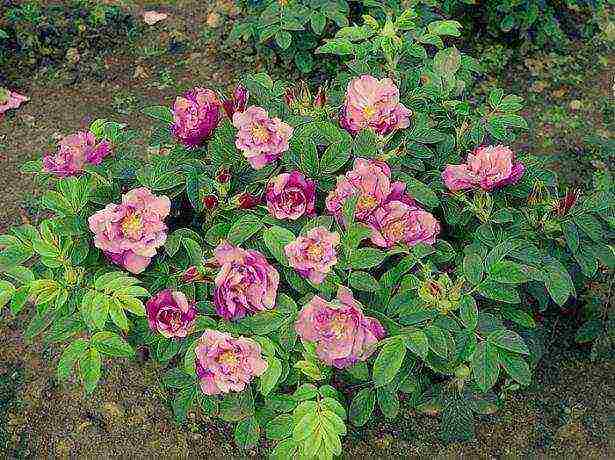
Wrinkled rose bushes are ideal for creating a flowering hedge
Recommended varieties of Rugosa rose:
- Grootendorst series (pale pink flowers Pink, pure white White and dark crimson Supreme);
- Frau Dagmar Harlopp - blooms on salmon pink flowers on any soil, surprisingly unpretentious;
- Rugosa Alba is a popular variety with purple-red, non-double flowers;
- Sarah Van Fleet with very fragrant pale pink double flowers;
- Roseraie de I’Hay with wine-red double flowers is very hardy and unpretentious;
- The Queen of the North is the hardiest red-flowered variety suitable for fairly cold regions.
Other varieties of roses adapted for Russian winters 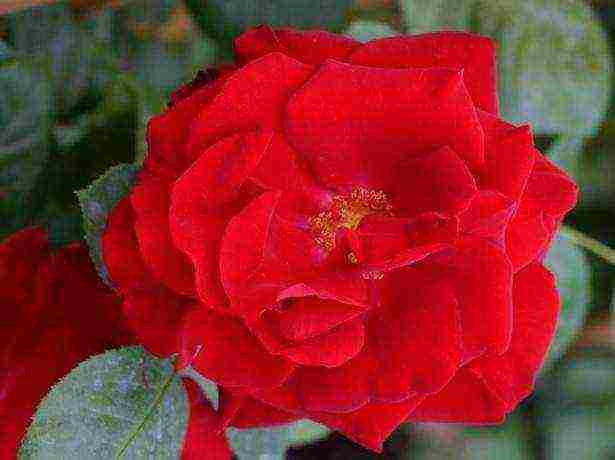
Rose Santana
Among the most popular winter-hardy varieties in our country, a special place is occupied by climbing rose santanabelonging to the Climber group. Of the red roses, velvety bright red Santana is considered one of the most beautiful. Large semi-double flowers with slightly wavy petals abundantly cover vigorous dense bushes throughout the summer season until the first frost. The height of the bush can reach two and a half meters, and in some cases grows up to four meters. You can grow the Santana rose as a shrub or as a climbing plant. The variety is quite resistant to common diseases and is not afraid of rain.
Another notable variety from the climbing group is New dawn... These roses are planted in groups or singles in a flower garden, and are also used for vertical gardening. On the bushes of the New Dawn variety, charming pale pink double roses with a diameter of up to seven centimeters are formed. The flowers are collected in inflorescences and exude a wonderful apple aroma. Flowering lasts from mid-June to mid-October. One of the best autumn varieties of roses, even in severe winter frosts, its apical shoots only slightly freeze.
The unpretentious frost-resistant variety of hybrid tea rose is highly valued throughout Europe. Madame Meilland (Meiland), which has different names in different countries: Fredsrosen, Gloria Dei, Mme Antoine Meilland, Peace, Beke, Gioia. Roses look very elegant at any stage of flowering - from elegant creamy buds to lush blossoming flowers with a pink border, exuding a pleasant fragrance. The aroma of roses and the color of the flowers largely depend on the place of cultivation.
Video about varieties and selection of roses
From the group of grandiflora roses, it is worth noting the variety Quin elizabeth with cupped large double flowers of traditional pale pink color. Flowers, reaching a diameter of twelve centimeters, are located on the bushes singly or in the form of inflorescences. Flowering lasts from June to October with short breaks. In addition to its high winter hardiness, the variety is resistant to fungal diseases.
Novice growers can start growing roses by growing popular floribunda varieties. Abundantly blooming floribunda roses are less whimsical than hybrid tea, they are more resistant to frost and fungal diseases, they are ideal for a small area. Common varieties: Masquerade (dark red, yellow, pink flower color), Amber Queen (amber color), Allgold (golden yellow variety, very easy to grow), Chanelle (reliable variety with peach-colored roses), City of London (bright pink), Korresia (with very fragrant golden flowers that are not afraid of rain), Parfait (creamy pink roses for universal use).
Rate the article:
(0 votes, average: 0 out of 5)
